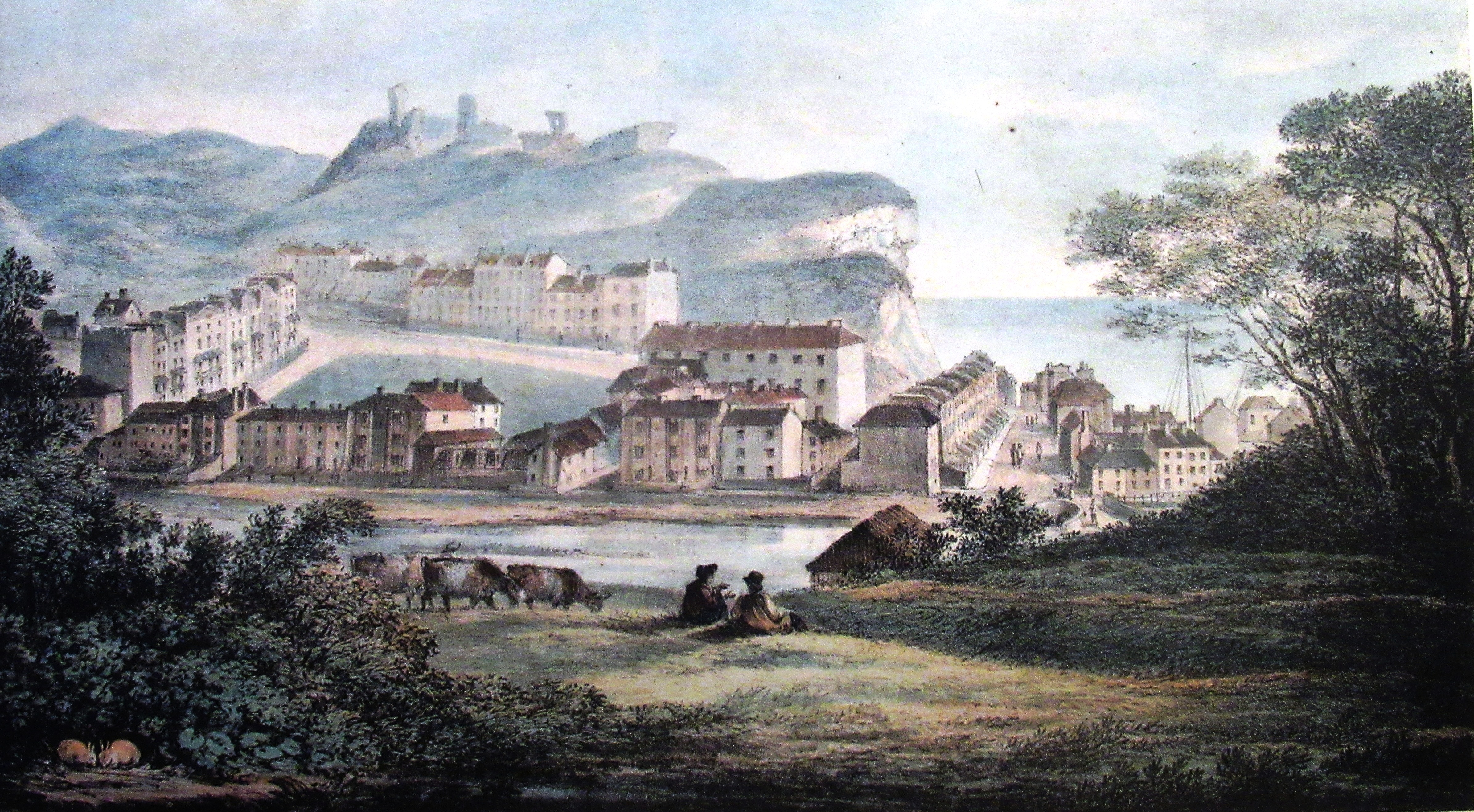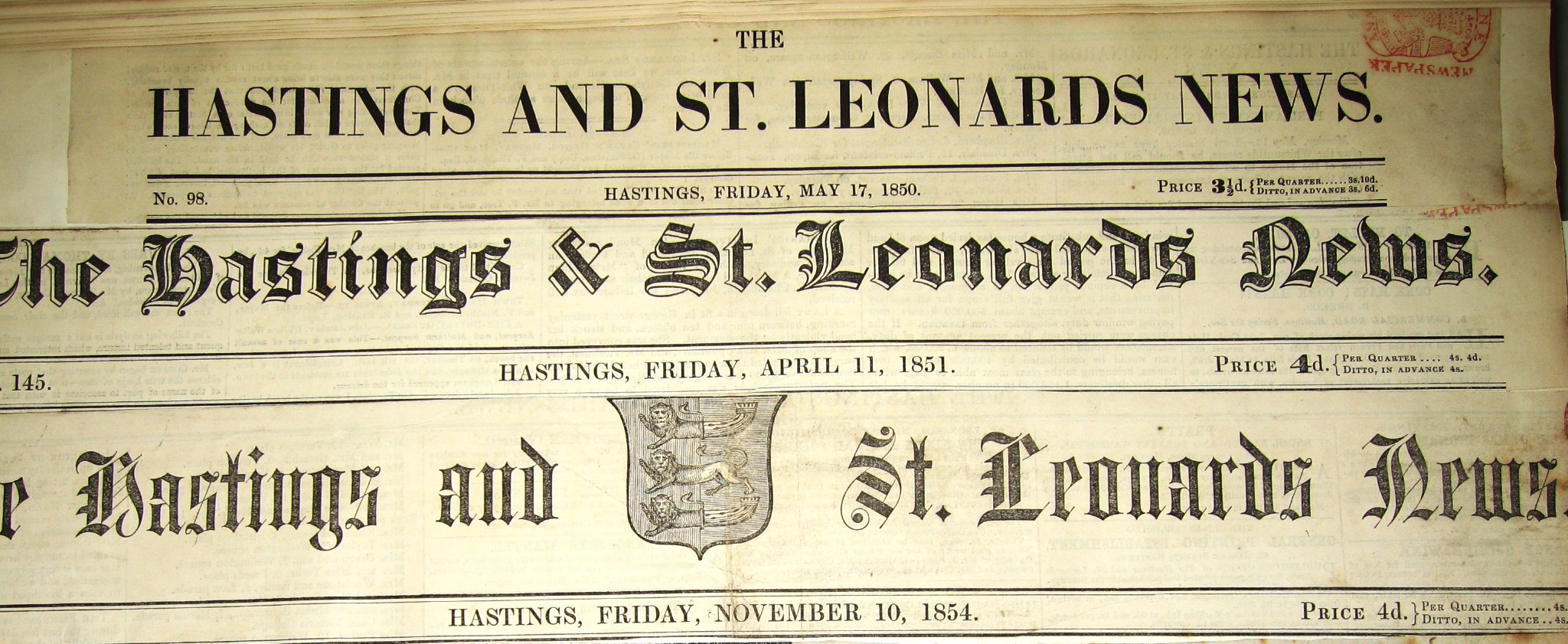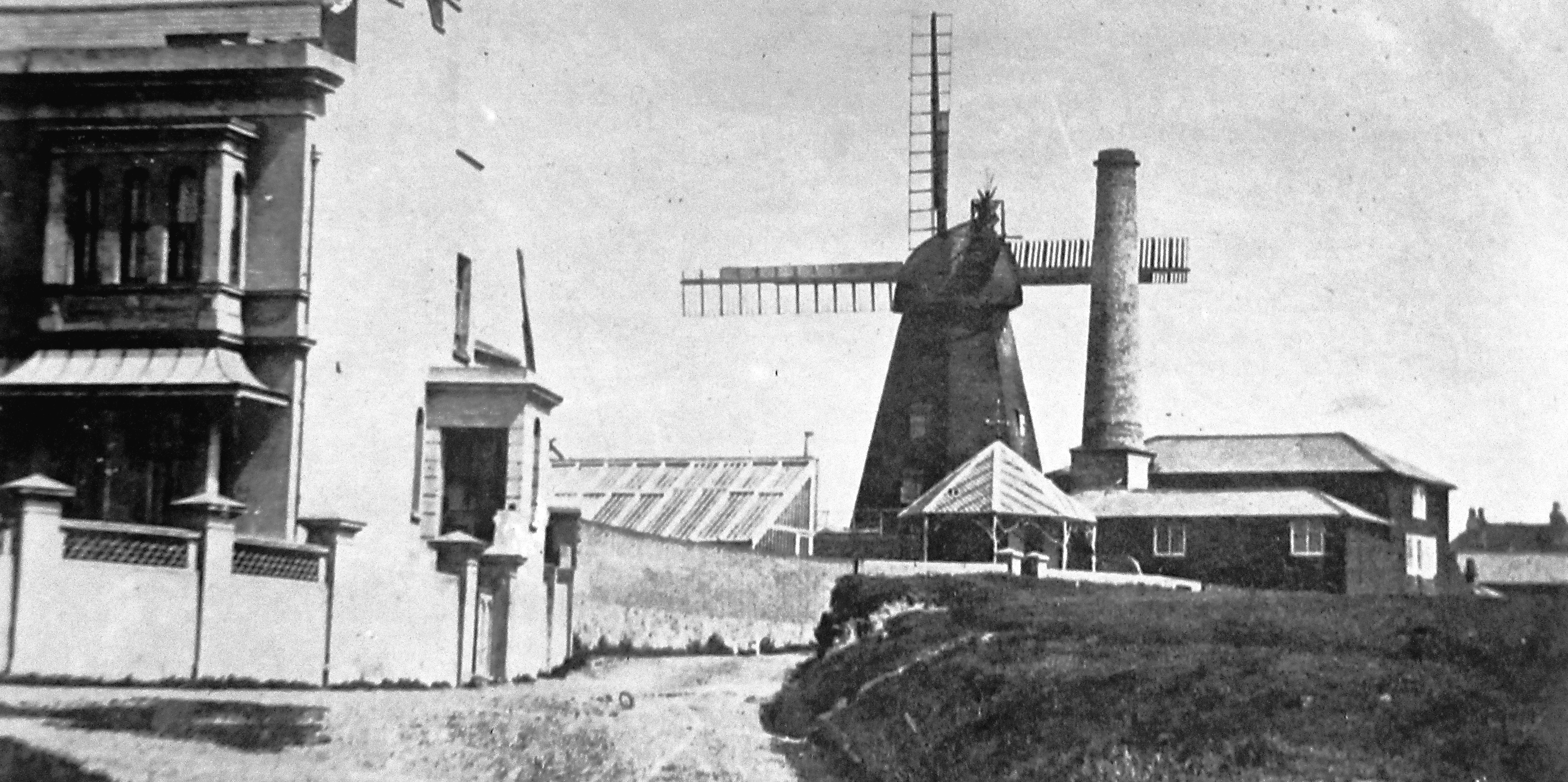1800-1849
1800 - As Hastings expanded, the first major development took place on the America Ground (then commonly known as the Priory Ground). This was a large shipyard and rope-walk, erected by the Breeds family, who were the principal ship-owners and merchants in Hastings in the late 18th and early 19th centuries. Their layout was to determine ways in which the Ground was built upon in the following years.
1800-01 - A new, wooden bridge, 20 feet long and ten feet wide, able to take carriages, was built over the Priory Stream, near where the Memorial was to be built in 1862. This stream-crossing was a key part of the only road going west from Hastings. The section of road going up on to White Rock was improved in 1797; the road was then called Hollow Way because it was cut into the rock; it is now named Dorset Place.
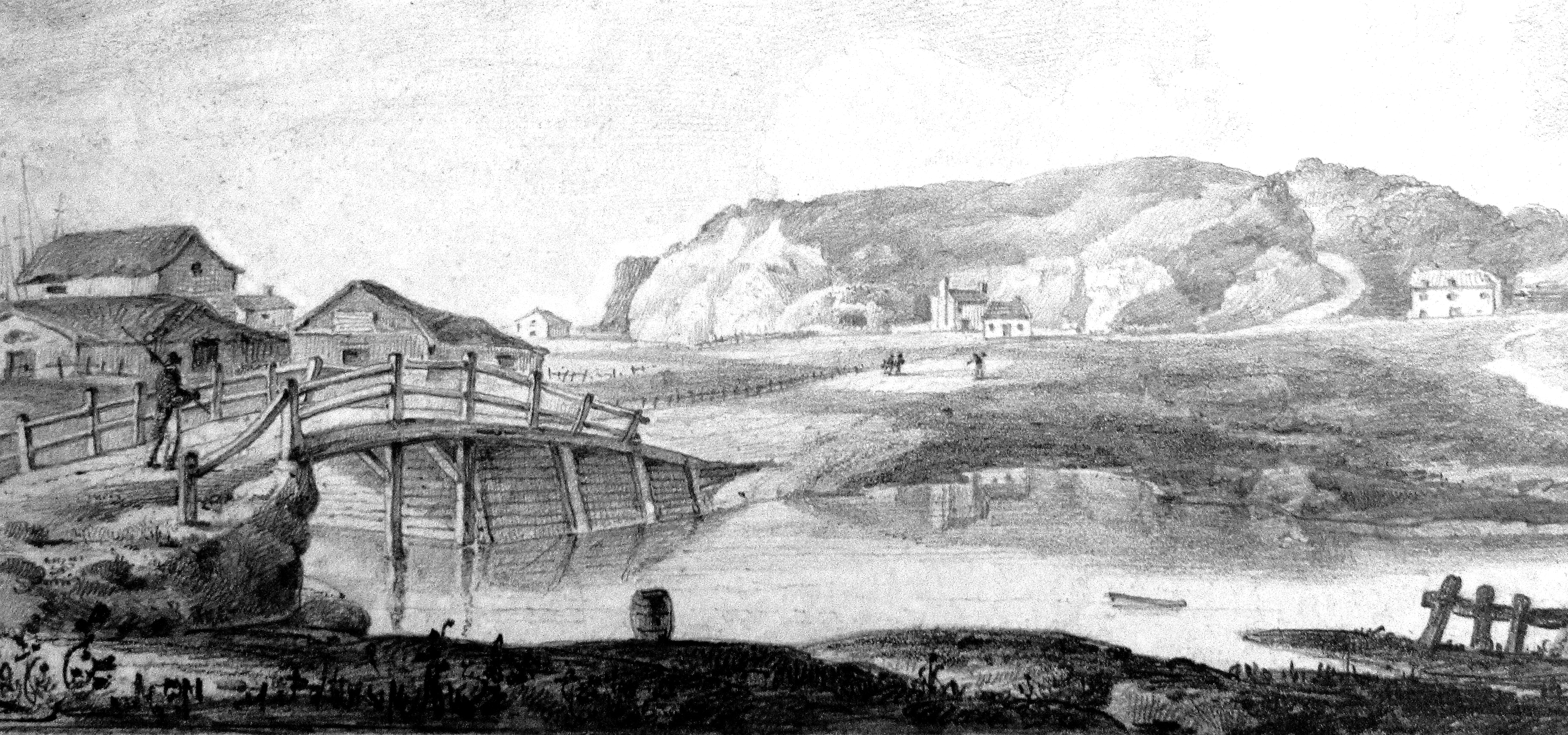
The bridge over the Priory Stream. Cambridge Road is going up onto White Rock. On the right is the farmhouse of Priory Farm.
1800 Feb - Because of severe weather, the exorbitant price of bread and fuel meant many people were starving. Letters were sent to farmers threatening to burn cornstacks and houses if the price of flour was not cut. Rewards were offered for apprehending any threateners. A soup kitchen was set up, giving the needy a quart of soup for one penny twice a week. The price of wheat rose to £27 a load at the end of February; in November 1798 it had been £13. But in early May the poor people benefitted from the large quantities of fish that were landed.
1800 Nov 9 - The worst storm since that of November 1703 (cf) took place, causing much damage. A recently-erected smock windmill was blown down.
1801 Feb 10 - As bread had risen beyond the purchasing power of the poor, a large mob assembled outside the house of the mayor, Edward Milward, and broke some of his windows. There were soup kitchens again.
1801 July 30 - All military Volunteers around the country, including those at Hastings, were ordered to hold themselves in immediate readiness for a French invasion. In March 1802 the nine-year conflict came to an end with the Treaty of Amiens, and that July the barracks at Bopeep were sold. But in May 1803 Britain declared war on France after Napoleon violated the treaty.
1803 - Two houses were built at Marine Parade, west of the fort, soon to be followed by others, including the Albion Hotel.
1803 Jan 1 - The Hastings Bank, the second bank to be started in Hastings, came into existence. Based at 33 High Street, it was a partnership of Edward Wenham, Thomas and Mark Breeds, and Henry and Thomas Farncomb. The Breeds family were the predominant merchants in Hastings for most of the first half of the 19th century, owning a large range of businesses, including many coastal sailing vessels that were the main means of trading before the coming of the railways c1850. In 1812 the partners purchased from Edward Milward the Swan Inn, in High Street, the town's most important and oldest inn. In 1815 the bank bought from Milward land to the west of castle, for the building of the Castle Hotel, much of Wellington Square and Russell Street. Mark Breeds was given £16,000 in December 1816 to cover the hotel and the first houses in the Square (initially called Waterloo Square). The partnership ended 31 December 1819, but the Breeds brothers carried on running the bank. The Swan was sold to Wenham in 1820. The bank closed c1824-25.
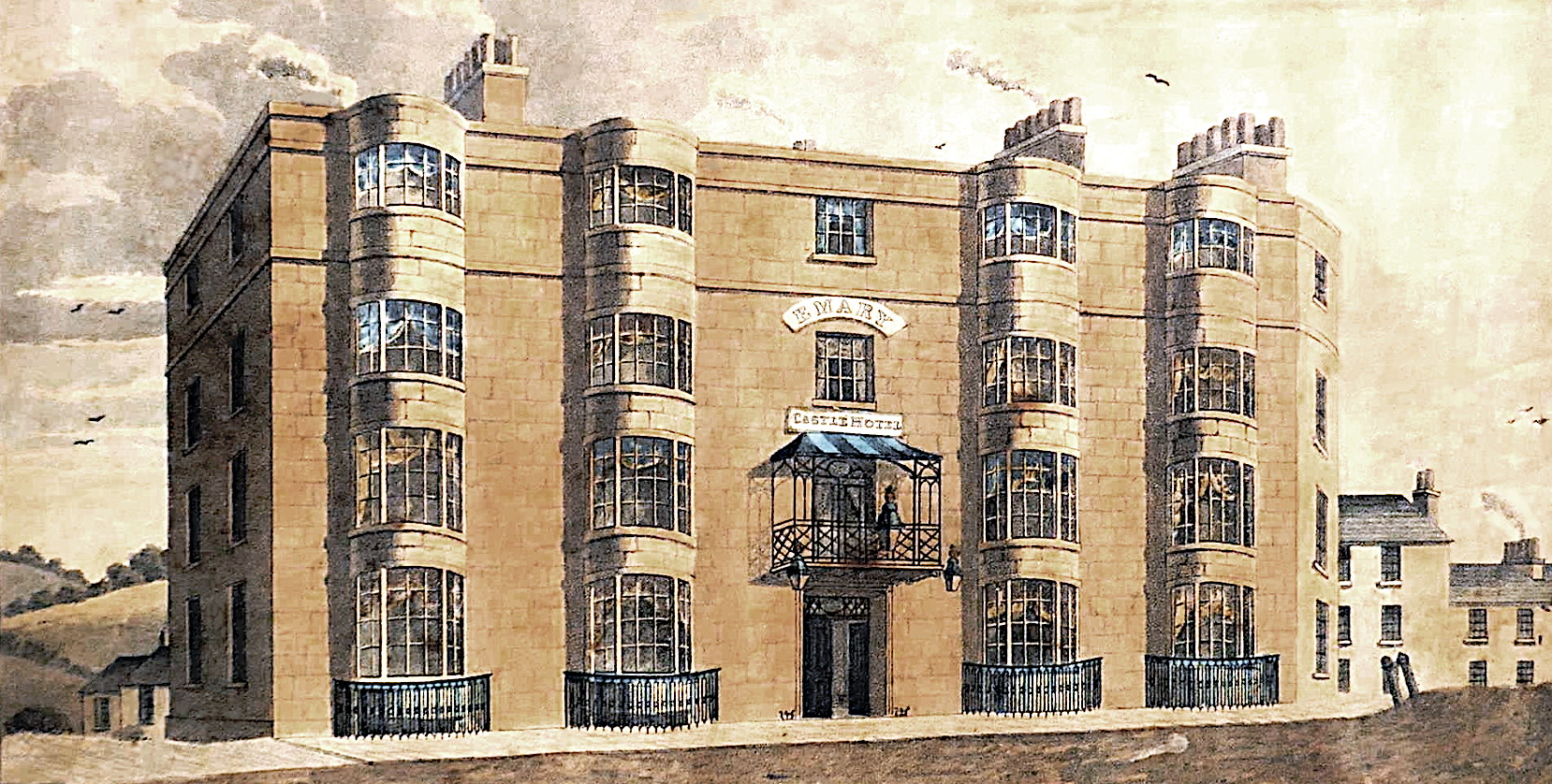
The Castle Hotel at the bottom of Wellington Square, in the 1830s.
1803 Spring - A serious outbreak of influenza caused many deaths, most of them infants.
1803 June 9 (?) - A torrential thunderstorm caused widespread damage. The Bourne stream overflowed, streets become rivers and many houses were flooded.
1803 Aug - The government War Department advertised for labourers, carpenters, joiners, masons, and bricklayers to work on the large set of barracks it was planning to start building on the several acres of land it was buying at Halton. This was partly in fear of the French invasion, then believed imminent, but also to house soldiers acting as a police force at a time of widespread social unrest. The land was bought in January 1804 and the barracks were built and occupied by the end of the year. They were the main barracks in the Hastings area. In 1823 Mark Breeds bought the then redundant barracks for £3,000 as building land. The original plans for the development seem to have been more grandiose than for the working class housing that was actually built in the following years. Much of the area was cleared for council houses in the 1960s.
1803 Autumn - The resumption of war with France highlighted the need for improved defences, including the setting up of a new beacon warning system along the south coast to help inform and unite the many military forces. So in the early autumn of 1803 the Army set up a new nationwide chain of signal beacons to alert people inland, leaving the Admiralty’s 1794 signal stations to cover the coast. Fourteen stations were set up in Sussex in 1803, including one on Fairlight Down. The beacons were tall simple piles of combustibles, especially gorse. Dragoons were stationed in rough huts by the Fairlight Down beacon, ready to ride with despatches to the Army commander based in Hastings (there were then 2,100 infantry in and around Hastings, including Fairlight Down). It was possible to signal warning of an approaching invasion over a distance of 100 miles in 15 minutes. At the same time the Army set up a pioneering telegraph system between Winchelsea and Brighton. A tall mast, with flags, balls and pennants, was erected on Fairlight Down, linked to Winchelsea and Bexhill. The Cinque Ports Volunteers, set up in 1794, were enlarged, with a second company being formed. The 1803/5 fear of invasion soon passed, however, and as the infantry moved away, the telegraph system either went with them or was dismantled later. The beacons stayed in place for a few years, until the French looked even less of a threat.
1804 - A half-mile dyke - ‘Bonaparte’s Ditch’ - was dug between Harley Shute and Bulverhythe Hill, possibly as a defence against a French landing. (Today, it would run south-west from the west junction of Bulverhythe Road and Cliftonville Road, parallel to, and halfway, between Bexhill Road and the railway line.) Construction of the Royal Military Canal, between Seabrook near Folkestone and Cliff End, was started on October 30 1804. Digging began at Seabrook, but the 28 miles were not completed until April 1809, long after the threat of Napoleon’s invasion had passed. It cost the astronomic sum of £234,310 and was widely dismissed as a waste of money and a folly. It is the third longest defensive monument in the UK.
1804 Jan 23 - A British sloop with a valuable cargo was captured by French pirates, but was retaken, with the help of Hastings fishermen. There was much privateering in 1803 and 1804, especially by the French. In 1804 there were nine privateer gunboats at Hastings, under a superintendent, ranging from 34 to 156 tons. Plus some fishing boats were fitted with a 12-pounder carronade. In 1804 there were 13 coasting vessels belonging to Hastings, one of 157 tons, the others between 36 and 88 tons. There were 97 fishing boats.
1804 Feb 16 - The temporary wooden barracks housing about 200 soldiers at Bopeep were burnt down. Burning soot from a flue had set light to the thatched roofs. They were rebuilt, being the property of Messrs Ovenden and Adams.
1805 - The independent Croft Chapel, the first dissenting (nonconformist) place of worship in the town, was built at the junction of Croft Road and the Croft. But there was so much local prejudice that no Hastings tradesman dared to build it, so the wooden building was made in sections in London and brought to the town by sea. It was rebuilt in 1820. Around 1805, the Croft, a ropewalk until then, was sold in plots for building better houses to accommodate visitors.
1805 - Around 1800, James Barry, owner of the Marine Library at the west end of George Street, had built a small seafront parade opposite his library. In 1805 he was the main financier of making the parade somewhat more substantial, and extending it in front of more nearby buildings. By then it had become known as Marine Parade, and was the town's first seaside 'promenade'. Barry raised much of the money to rebuild and extend the parade westward after it was severely damaged in a storm in 1812. The new parade was 500 feet long and 15 feet wide.
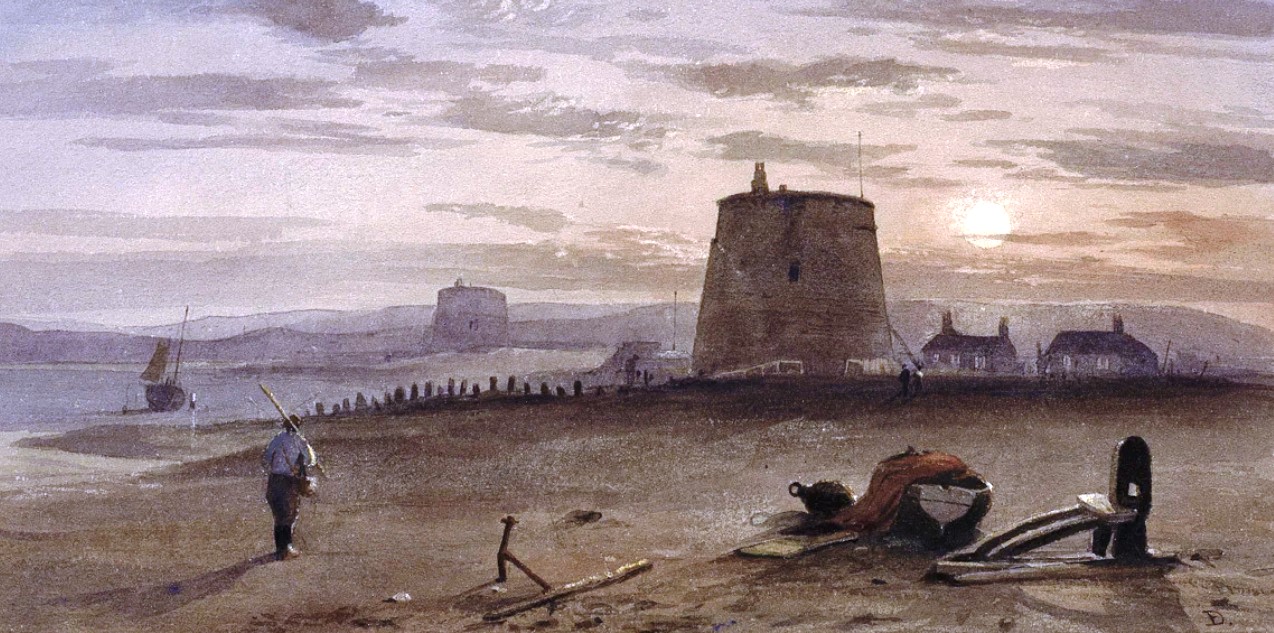
Martello Tower number 39, at West Marina. The staff lived in the cottages on the right, now where the Aldi supermarket is in Bexhill Road.
1805 April - Work started on building 74 Martello Towers along the south coast between Folkestone and Seaford because of the threat of a French invasion. Nelson’s victory at the Battle of Trafalgar in October 1805 made the heavily fortified towers unnecessary, but work continued on them, not being completed until 1808. The nearest to Hastings, No 39, was at West Marina, where today is the junction of Grosvenor Gardens and Sea Road; it was lost in the late 1870s. From here a line of them went west to Eastbourne. Nos 40-42 were on the beach at Bulverhythe (40 was blown up in November 1873 as the sea undermined it; 41 was swept away in a storm in February 1842; 42 was undermined by the sea in 1840). No 43 was on Bulverhythe Cliff, opposite the Bull Inn (dismantled late 1868). The nearest to the east was No 38 at Cliff End, from where they were spaced at about 600 yards eastward. Each tower required about 400,000 bricks, and several large brickfields were set up to make them, including one on the edge of the coast between Glyne Gap and Galley Hill. Bricks, lime and other materials were supplied in this area by Henry and Thomas Farncomb, and Mark and Thomas Breeds, who made a profit of many thousands of pounds. Along with Edward Wenham, they began the erection of Wellington Square, Russell Street etc.
1805 July 16 - The town assembly ruled that no buildings should be erected on the Stade, between the East Well and the West Fort, without the corporation's permission.
1806 - Famous engineer Sir John Rennie produced a plan for a harbour where Robertson Terrace is today, but this came to nothing.
1806 Jan 26 - Sir Arthur Wellesley (the Duke of Wellington from 1809) held a ball at the Swan Hotel just after taking command of the brigade in Hastings. His base was 54 High Street and he stayed at Old Hastings House (now Humphrey Avenue). On 6 April Major-General Wellesley married Elizabeth Pakingham. Hastings was a garrison town, accommodating 12,000 troops at Halton in 1807, waiting for possible invasion.
1806 April 23 - The Customs and Excise cutter Leopard sprang upon a smuggling vessel off Worthing after a long chase and the captain, Edward Aldridge of Hastings, was shot dead. Aldridge, aged 41, was buried at All Saints Church on 30 April, surrounded by a great crowd of sympathisers. 'Wilful murder' was written in the church register. On 23 May another Revenue cutter tried to board a smuggling boat off Deal, but the smugglers, angry and incensed by the killing of Aldrige, opened fire on the Revenue officers, killing one of them. The smugglers then ran their boat ashore, where some 200 men, mostly armed, unloaded the vessel and nine other craft. The Revenue cutter also came ashore, but the smugglers surrounded the craft, stowed it in, and disarmed and maltreated the crew. In the autumn smuggler John Moon, of Westfield, was shot dead while running contraband. The public were generally very sympathetic with the smugglers because of the unnecessary violence of the Revenue.
1806 May 26 - The Sussex Weekly Advertiser reported that on 18 May 'A duel took place between at Bopeep between two officers of the 3rd Buffs, which after the parties had exchanged four unsuccessful shots, terminated by an exchange of civilities.'
1806 June 2 - It was reported that a vein of coal four feet thick had been found in Bexhill. Many miners were going to be employed, and a shaft was to be sunk.
1806 July 1 - The town’s first theatre opened - just outside the borough boundary, in an annexe to the Hare and Hounds pub in Ore, opposite the church. The theatre was a weather-boarded building, painted white. On the opening night, the play was a comedy called 'The Soldier's Daughter', which was popular with the many soldiers garrisoned at nearby Halton. The annexe burnt down on Boxing Day 1867.
1808 Feb 19 - Mr Joseph Carswell’s windmill, known as the Priory Mill, on Cuckoo Hill (White Rock) was blown down in a severe storm. Mr John French’s mill on the West Hill was badly damaged. Both had owned those mills since at least 1785.
1809 Sept - HM Customs were given a 21 year lease by the town for a plot of land at Mercers Bank to build a ‘Watch House and Searchers Office’, measuring 32’ x 14’. The lease was renewed in 1831. In 1843 the building was replaced by a new one on a different site, but its location is uncertain.
1809 Dec - Four eagles, one much larger than the others, were seen hovering over the Hastings cliffs.
1810 - Local businessman Thomas Breeds applied to the High Court of Chancery, alleging that Hastings Corporation was fiddling the financial management of the William Parker charity that had set up the town’s main school in 1619 (cf). The Court later ruled that members of the local establishment - including Edward Milward Jnr and his doctor - had been letting the Parker land at very low rents to their fellow freemen. The school’s low income had forced it to merge with the Saunder’s school (cf) created in 1708-9. The Court ordered that the land be rented properly, that the charity should keep proper accounts, and that the two schools be separated. But the corporation had spent so much on defending itself that Saunders could not start again until late 1818, when Breeds provided free space in a warehouse on the America Ground.
1810 - There may have been an outbreak of influenza, causing many deaths.

York Buildings, the line of properties behind the Albert Memorial clocktower, in 1863.
1811 - The first two houses of York Buildings were built. This was the beginning of development in the Priory Valley outside of the America Ground. They were apparently built by William Ransom and William Ridley, who ran a shipbuilding business on the beach opposite. They were on the site of the existing line of York Buildings shops, which were originally houses, probably named in honour of the Duke of York who was in command of a mock battle that took place at Bulverhythe. Behind them today is the back-street called York Gardens, where originally the houses had gardens. The big shipbuilding yard, where many large vessels were built, had been in operation for many years, closing in the 1840s when the owners were in their 70s and there was much development taking place around them.
1811 July 4 - Death of Edward Milward Snr, aged 89. He and his father-in-law John Collier (1685-1760) were seen as having been the most powerful individuals in the town for almost a century. He bought Old Hastings House from a relative in 1796. His property passed to his only son Edward Milward Jnr (1765-1833). Local journalist and author Thomas Brett recalled that Edward Snr had been mayor every other year for half a century, but was an invalid for some few years before his death and left the mayoral business in the hands of his son and Mr John Goldsworthy Shorter. 'During his long life he [Edward Snr] had become a very rich man, and was less a philanthropist or public benefactor than was his son.' His remains were deposited in the family vault in St Clements Chuch. Edward Jnr in 1817 married Sarah (1787-1873), daughter of the local Rev William Whitear. But the marriage was childless, and when Edward Jnr died in 1833, the estate of more than 2,500 acres passed to Sarah, who became the Countess Waldegrave in 1846. A strong Protestant, she was very generous, aiding many charities and not allowing development in what is today the Hastings Country Park Nature Reserve.
1811-12 - Fairlight Place, Fairlight Down and other land was sold by Sir Godfrey Webster to Edward Milward Jnr. The Down had been common land, but Milward enclosed much of it with hedges and banks, and later sold some of the lower western slopes, where houses were built. These were the basis of the urban development that became Ore village. In the 1820s the village grew quickly, as it was on the only main road into Hastings - now Old London Road and The Ridge - as the town became a popular seaside resort.
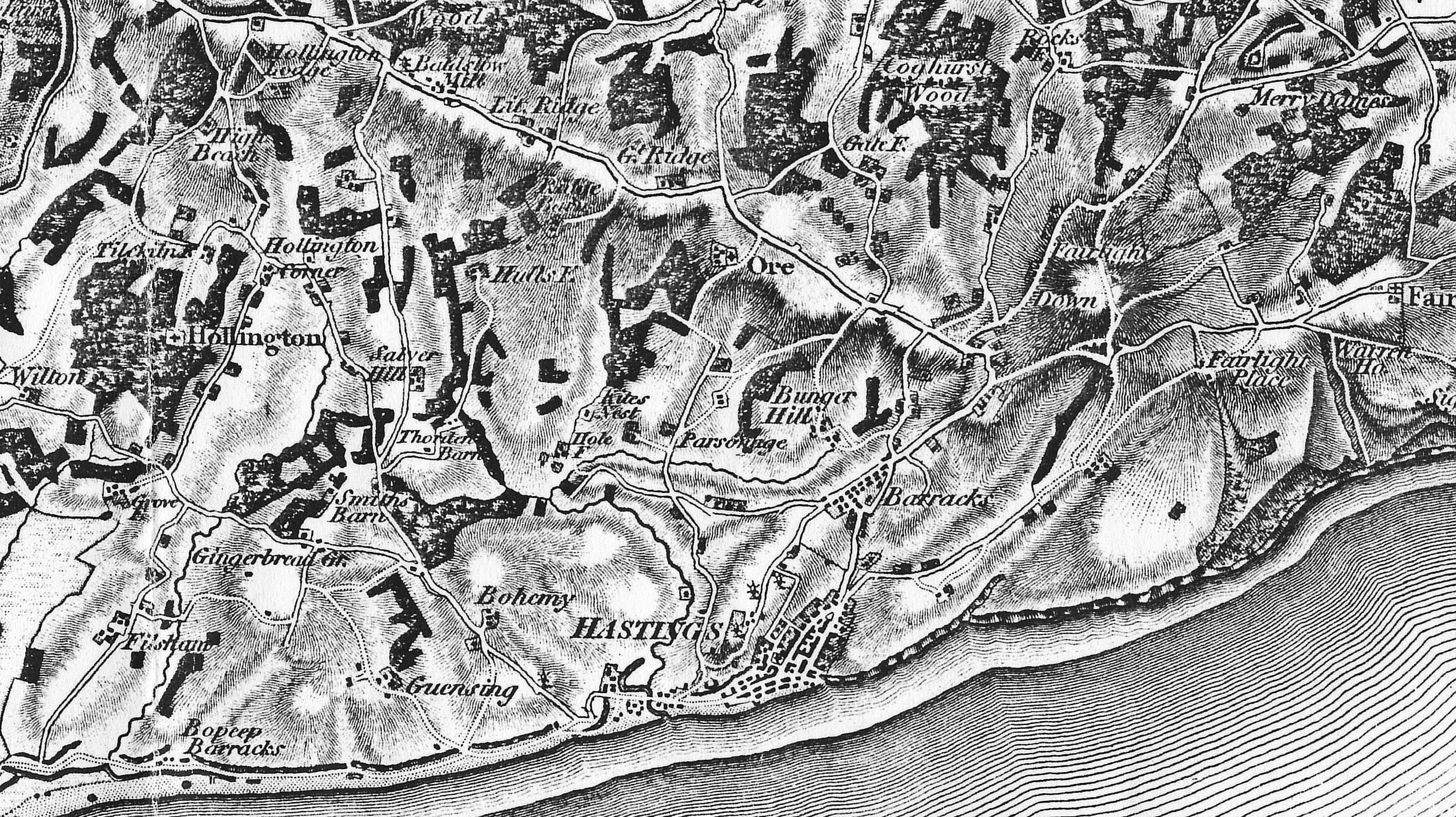
The first Ordnance Survey one-inch-to-the-mile map, of 1813. It was surveyed several years before then.
1812 Oct 20 - A severe gale with very high tides washed away much of the road under the cliffs between Warrior Square and Bopeep, so a new road had to be formed. At the same time, Marine Parade, built in 1805, was severely damaged, so a subscription was raised to rebuild it. This took place in late 1812 and 1813, and at the same time it was extended to 500 feet long. It ran westward from the west side of the 1760 battery to the east end of what would become Pelham Place in 1820. A parade was built in front of Pelham Place to protect it from the sea. Severe storms in late 1823 and early 1824 forced the virtual rebuilding of both parades in 1825. They were then joined together and improved, being furnished with rails, lamps and seats. In following years the joined parade was gradually extended in both directions.
1813 - Opening of the Hastings Library, the town's third visitor’s centre, after Stell's of 1788 and Barry’s libraries of 1791 (cf). It was at the west end of West Street, on the seaward side, facing west along the seafront (where the round-fronted fish and chip shop is today). It is believed that this was the library recently opened by Richard Diplock, who went bankrupt in the autumn of 1813, forcing him to sell the lease on his library and all the contents, plus his house at the top of High Street. The library's new proprietor was Peter Malaperte Powell, son of a Grandee of Spain, who published the second Hastings guide book, in 1817. Mr Powell was said to be a man of great energy and enterprise, who did much to promote entertainment. He rebuilt the library in 1825 but in 1830 went bankrupt. The contents of his library were auctioned on 5 January 1831, and he migrated to America.
1813 April 29 - Hastings Corporation rejected a request by 'Messrs Jonas and Penley, comedians', to build a theatre, despite there being theatres in most other towns.
1813 May 5 - The second Freemason lodge in the Hastings area, the Derwent No 40, was founded at a meeting in the Cutter Inn. It was set up with the help of members of a military lodge who were then stationed in the town to repel a Napoleon invasion. The landlord of the Cutter was John Bell, a Freemason who had been valet to Lord Nelson. In December 1817 the Derwent merged with the other Hastings lodge, the Harmony, of 1799. It still exists, and is based in the Masonic Hall, East Ascent.
1814 - Birth in All Saints Cottage, All Saints Street, of Frederick Thatcher, who became an architect. He designed the former Battle Union Workhouse (1840), now a grade II listed residential building, and in 1843 emigrated to New Zealand, where he designed many public buildings and churches, including the Anglican Cathedral in Wellington (1866).
The remains of the 1597 harbour, on a misty day in the 1880s.
1814 Jan - The remains of the Tudor harbour were exposed more than anyone could remember. They were an accumulation of large rocks between pointed wooden piles, with crossbars, in parallel lines from the south-east and winding in semi-circular location to the north under Marine Parade, seeming to terminate at the foot of the declivity from the West Hill. The exposure was the result of the parade being built, causing a backlash to the east of it. This eastern backlash has been a feature of nearly all large groynes built in Hastings since then.
1814 April 6 - The war with France came to a (temporary) end when Napoleon abdicated. By early May, Hastings was being visited daily by people from France arriving in boats anchoring close to the beach, and bringing many provisions. There was a day of celebration on 28 June. That summer Hastings was crowded to excess with visitors, and construction began of new houses. Mr Barry enlarged his library, and a new bigger one was built by Mr Powell.
1814 July - Lord Byron rented Hastings House for the summer season. He wrote to a friend: 'I have been swimming and eating turbot, and smuggling neat brandies and silk handkerchiefs ... and walking on the cliffs, and tumbling down hills.'
1814 Late Aug - The King’s German Legion of over 5,000 troops left Hastings and Bexhill.
1815 - Formation of the Hastings Friendly Society, raising money to help its subscription-paying members in distress. This was the first of many similar societies to be set up in Hastings. These included the Hastings Benevolent Society in 1821, a Grand Lodge of Druids in 1822, the Victorian Lodge of Oddfellows in 1837 and a branch of the Shipwrecked Fishermen's and Mariners' Benevolent Society in 1821.
1815 - Edward Milward Jnr and Edward Shadwell funded major improvements to the Old London Road, laying it out as it is today. Prior to 1815 the road had been a difficult track, then much steeper between what is now Halloway House and Ashburnham Road, above which it almost levelled out to the bottom of Robertsons Hill. This steep hill above Halloway House was about 25 yards to the west of today's road, which was created by cutting into the bank on its east side. At Halloway House the level of the road was lifted to give a smoother and wider slope down towards the High Street. In addition, the Bourne stream was covered over at the junction of High Street and All Saints Street (the Milward's house was at the top of High Street, opposite Mr Shadwell's in All Saints Street).
1815 June 18 - The Battle of Waterloo finally ended the Napoleonic War. Hastings then became a fashionable seaside resort and began many years of large-scale development. The Sussex Weekly Advertiser of 14 August 1815 said: 'On no former occasion have we had to record such an influx of company as hath this season poured into this fashionable watering place'. The Breeds family, backed by the Hastings Bank, in December 1815 bought the Priory Field in the Priory Valley from Edward Milward Jnr, where they built in following years the Castle Hotel, much of Wellington Square and Russell Street. Mark Breeds was given £16,000 in December 1816 to cover the cost of the hotel and the first houses in the Square (initially called Waterloo Square; Russell Street was first known as Blucher Street, after Wellington's fellow-victor in the Battle of Waterloo). Until 1815 there had been a lime kiln where the south end of the square is today. The east side of the square was built first, with work probably starting in early 1817. At about this time a prominent terrace of eight large properties called Beach Cottages was built on the seafront opposite where Pelham Crescent was later built. It was demolished by borough engineer Sidney Little in his reconstruction of the seafront in the early 1930s.
Wellington Square in the early 1820s.
1816 April-July - A a huge cloud of sulphurous gasses spread westward around the world following a three-month series of eruptions at the Mount Tambora volcano in Indonesia. This caused extreme weather conditions over the next three years, including in the UK, and the resulting suffering and shortages of food provoked civil unrest amongst poorer people.
1816 June-July - The Sussex Advertiser reported that 'crowds of fashionable and distinguished visitors' were arriving in Hastings from London daily. 'Extensive additions and improvements' had been made to the lodging houses, inns and attractions of the town. The newly-built Crown Inn, in All Saints Street, was a major attraction and was thronged with crowds of people. There were then four coaches regularly bringing the visitors, where previously there had been just one. New warm baths had just been built for Mr Powell, near the fishmarket.
1816 July 23 - Four Hastings smugglers were drowned in a gale off the French coast when setting out from Boulogne for Hastings with a cargo of contraband goods. Three others survived. The boat was Hastings-owned and the men all had large families. The survivors and three of the bodies were brought back to Hastings by French sailors.
1817 - The Parker boys school moved into what had been a corn warehouse on the site of today’s 16-20 Croft Road. But its one room was only 24’x14’, and by 1826 it had 133 boys!
1817 - The Ebenezer Calvinist Strict Baptist Chapel was built by David Fenner at the top of Ebenezer Road in the Old Town. Fenner was pastor until July 1868. It was enlarged in 1873 and again in 1882, when a schoolroom was added. A memorial stone was laid on 24 March 1886.
1817 - Smuggling had become so widespread and violent following the ending of the Napoleonic war that the government set up a naval beach cordon of armed marines between North Foreland and Dungeness called the Coast Blockade Service. The CBS replaced the 1809-formed Preventive Water Guard, which had been aimed at stopping smuggling as well as giving anti-French defence. The area was split into three divisions, with Hastings being the headquarters of the Camber to Cuckmere division, run from the Government House, where Sturdee Place is today. The CBS was the Royal Navy on shore, acting as a police force before the police had been set up. The 1820s saw an escalation in the violence used by smugglers, with many injuries and deaths on both sides. But eventually by the early 1830s the Navy did succeed, against much local hatred and an often hostile magistracy, in defeating the large smuggling gangs, and in stopping Sussex and Kent becoming ungovernable.
1817 June 16 - The Sussex Advertiser said that building work was under way in the Priory Valley and that plans were afoot to 'remove a considerable extent of the hill and cliff which project beneath the ruins of the castle, and erect a range of buildings fronting the sea'. This was to be Pelham Place. Work had started on building the north-east side of Wellington Square (initially called Waterloo Square). On 4 August 1817 the newspaper reported that 'The influx of company to Hastings for the past fortnight has been almost as incredible as it is indescribable.' All lodging houses were full, visitors were being turned away from the town and 'within the last two or three years Hastings may be said to be double its former size'. The libraries were providing evening entertainment and the New Warm Baths were very popular. 'The scene of fashionable gaiety, of innocent amusement, and of healthy enjoyment, never shone more conspicuous than at the present period.'
1817 July - William Smith, a labourer, was found guilty of stealing clothes worth 3s 6d (17½p) from Edward Milward and clothes etc worth 7s 3d (36p) from David Paine, and was sentenced to seven years transportation. In October 1817, Hastings tailor Francis Black was transported for seven years for stealing a £1 banknote.

The Castle Hotel in the 1830s.
1818 - The Castle Hotel in Wellington Square opened. It had been built on the site of a thatched house that had been a gin shop for many years. It was demolished in the late 1960s and replaced by a Tesco supermarket (today, Poundstretcher). In 1818 construction was well under way of Wellington Square and Russell Street, which was initially named Blücher Street, after Prince Blücher, the leader of the vital Prussian ally forces at the Battle of Waterloo. It was renamed after Lord Russell, the author of the 1832 Reform Bill. The gardens in the square were laid out in about 1824 as subscritpion gardens, surrounded by railings, exclusively for the residents of the square and their guests.
1818 - A strip of land on the East Hill overlooking the Old Town was bought at auction by butcher Humphrey Wickham, who sold plots to form a conspicuous line of houses called High Wickham. The large red end-house was built as Nos 14 and 15 in 1826-28, being merged into one house, Windycroft, after the Dannreuther family bought both in the early 1880s. One of the Dannreuthers was a musician who was visited there by Wagner and Tchaikovsky. Wallpapers throughout the house are original William Morris.

Behind the cart are the rocks that needed to be cut back to build Pelham Place. This is a view in 1784 from what is now the end of George Street.
1818 - From July to October, rocks at the bottom of the West Hill, below the castle, were cut back so that the houses could be built there. The work was directed by the Earl of Chichester, owner of the castle, who divided up the 420 feet of new ground into plots. By 1820 the first eight houses had been built, forming Pelham Place near the west end of George Street (Pelham was the earl’s family name).
1818 Sept 25 - Four sailors from the anti-smuggling cutter Camilla were drowned at Bulverhythe. The cutter was stationed off this coast and had six men ashore in a boat to obtain provisions. But the sea was very rough and the boat overturned. One of the two survivors was rescued by a smuggler, Mr S Beachen, who was nearby at the time.
1819 - The first edition of Powell's Guide to Hastings was published, by Peter Powell, owner of the Marine Parade Library. The last edition was the 8th, published c1833.
1819 - A Coast Blockade Service (CBS) watch house was built on a plateau just above the beach on the east side of Ecclesbourne Glen. This was part of the major attempt to stamp out the smuggling that had mushroomed since the end of the Napoleonic war. The CBS, consisting of armed Navy men nicknamed the Warriors, was the forerunner of the Coastguard. Around 1819 a CBS watch house was also built at the Haddocks, Fairlight Cove, and another on Fairlight Head, there either re-using, or roughly on the site of, the 1795 signal station. An Admiralty semaphore station was also erected at Fairlight, which the CBS used. All three watch houses - Ecclesbourne, Fairlight and the Haddocks - were occupied by armed Naval men who frequently attacked the increasingly desperate smugglers. The Navy largely won this war, and in 1832 the Coastguard took over the houses in a more life-saving role. The Coastguard had been formed in 1822 under the Board of Customs, although the CBS continued until 1831. The Ecclesbourne Station was extended in 1832 and a groyne was added on the east side in 1836 because the sea was encroaching following the construction of groynes at Hastings. It was washed away in 1859.
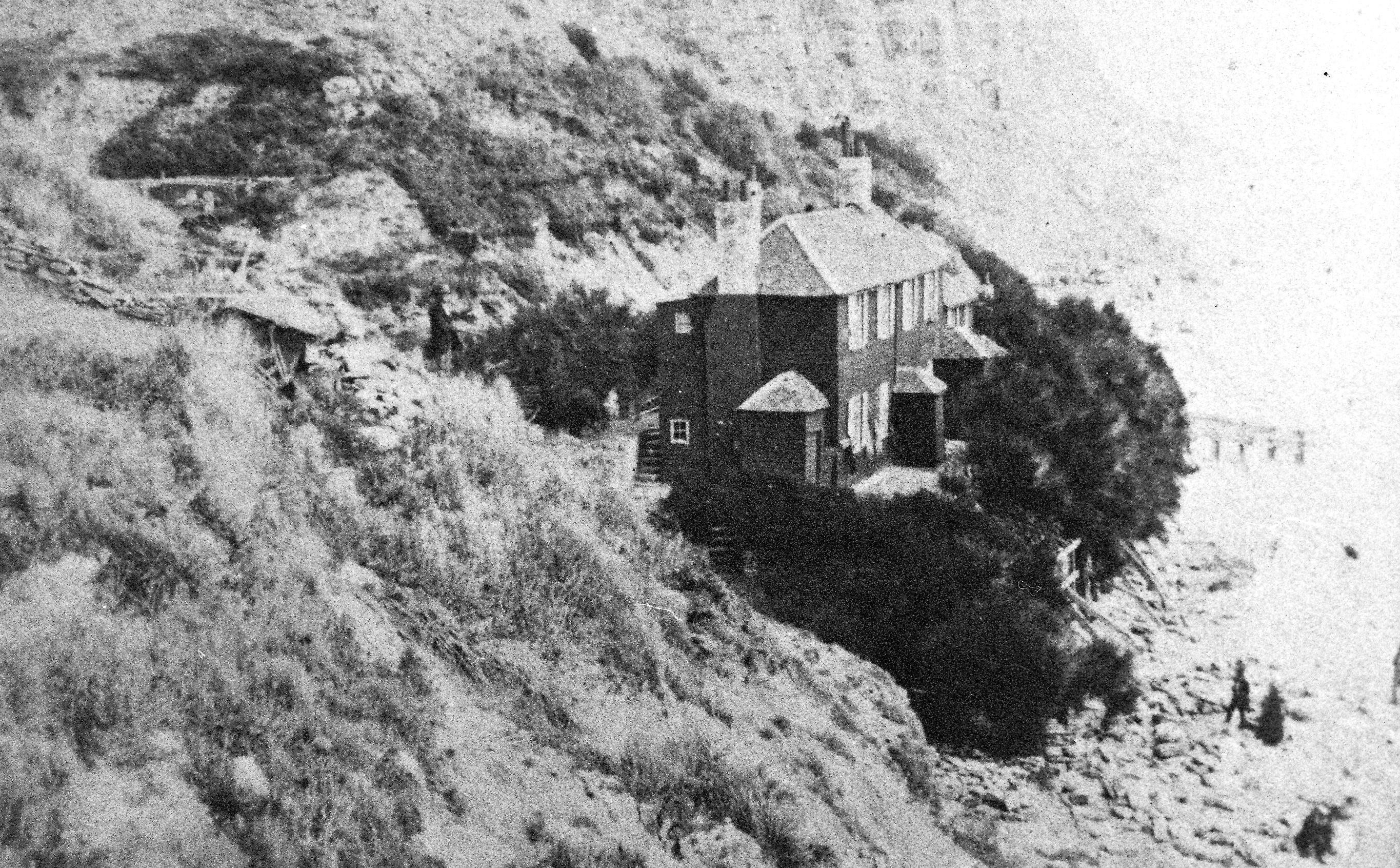
The Ecclesbourne watch house, built in 1819 and washed away in 1859.
1819 Oct 31 - A severe struggle ensued when a smugglers boat landed at Fairlight that night and was set upon by the Coast Blockade. One smuggler was killed - James Daniel - and seven others were arrested, including William Phillips, Henry White, Zebulon White, Henry Sargent and George Ball.
1820 - Croft Chapel, Croft Road, was built; it was demolished in 1876.
1820 Jan 10 - The Sussex Weekly Advertiser said about Hastings that 'This highly favoured watering place could never before boast so numerous and fashionable an assembly and company during the winter season.' Three weeks later it reported that a subscription had opened to supply coal to poor people during 'the severity of the seaon'.
1820 June 22 - The Hastings Improvement Act gave a new commission, run by the Hastings Improvement Commissioners, significant powers. It repealed the 1789 Act (cf), which had only applied to the parish of St Clements, and gave the commission similar authority to improve the roads and paths not only in St Clements but also in All Saints parish and that part of St Mary in the Castle parish east of the Priory Stream (ie, all the town's developed area in 1820). On 1 December 1820, the town’s new oil-fired street lights were lit, with about 125 lamps; they were turned off from 21 May to 15 October 1821. From late 1820, extensive road, passage and pavement improvements were started, drains were laid and the commission began covering parts of the Bourne Stream. The 1820 act was itself replaced in 1832 by a wider-ranging improvement act (cf).
1820 July 31 - The town's first refuse collector was appointed. William Catt picked up 'dust, dirt, cinders and ashes' from any premises and deposited it in one of two specific places, a compound at the bottom of the 'Tar Field' and near White Rock, where he could sift out and sell useable items.
1820 Sept - The Board of Customs and Excise was given a 21-year lease for a 'Condemned Yard' where boats caught smuggling were cut up. There was a large amount of smuggling in the 1820s. The yard was on the beach opposite what was to be the west end of Pelham Crescent, when it was built a few years later. By 1839 the yard had become something of an eyesore, so it was moved to Rock-a-Nore Road. See 1839.
1820 Oct - The old dilapidated gaol in Courthouse Street adjoining the Bourne Stream was demolished and replaced by a larger and better building on a slightly different site, to the north. In May 1822 wire gratings were placed over the gaol windows 'to prevent persons from throwing anything up to the prisoners'. In 1824 new rules were produced, with most prisoners only getting bread and water, except when labouring. In 1832 it was enlarged by adding another storey and making a yard.
1820 Oct 22 - A severe gale and unusually high tide destroyed the wooden Priory Bridge, built over the Priory Stream in 1800. A stone bridge replacement was built by the summer of 1821. This was itself removed and the stream culverted in 1836. Remains of the wooden bridge were found when building the front foundations of what is now the NatWest Bank in 1924.
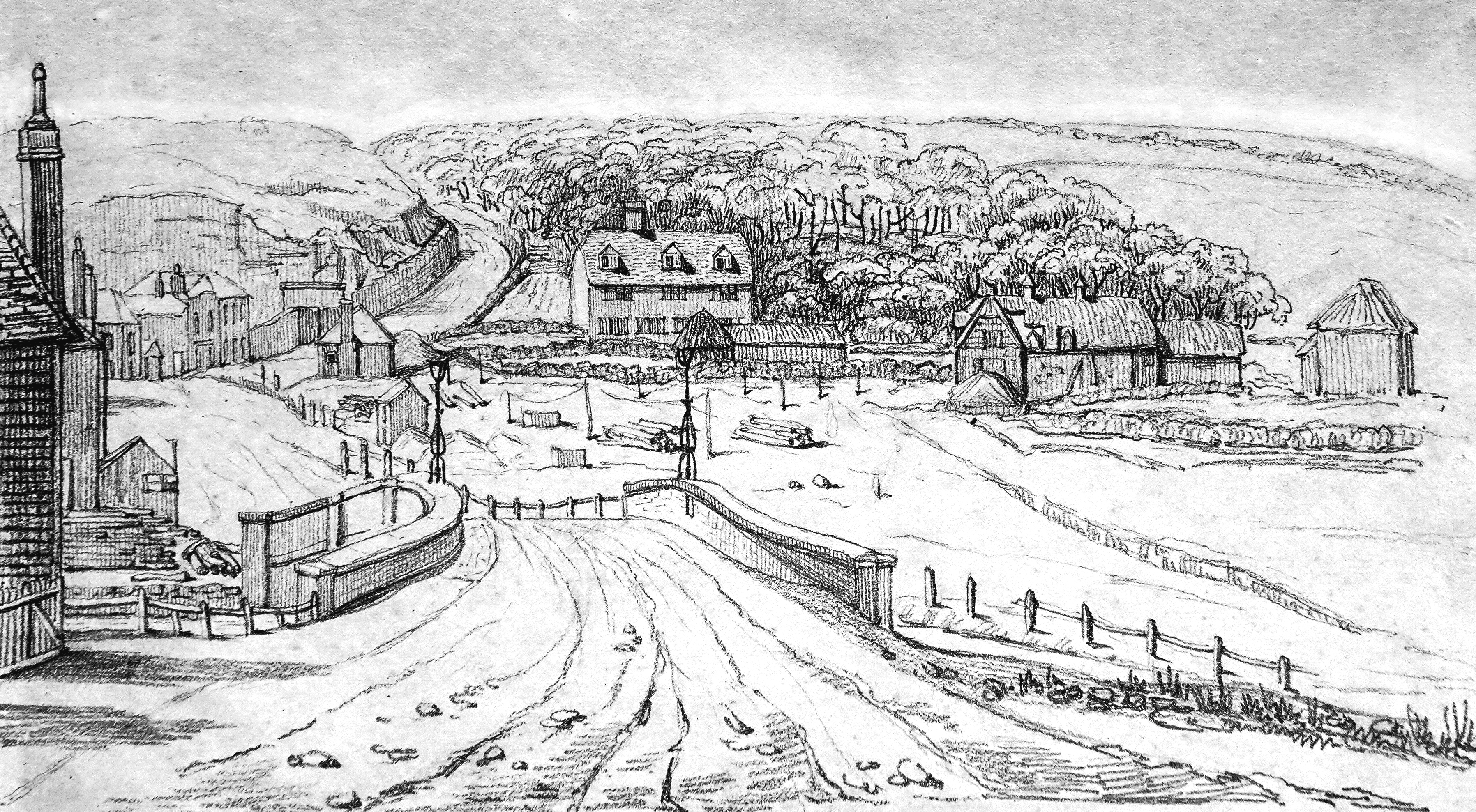
The 1821 Priory Stream bridge, seen here in 1830. Looking up Cambridge Road, with Priory Farm on the right.
1821 - The high pavements in High Street and All Saints Street were rebuilt.
1821 - Coast Blockade Service officer George England shot dead innocent Hastings fisherman Joseph Swaine on the beach while searching for smuggled goods. A furious crowd of fishermen cornered England, intent on murdering him, but he was rescued by a strong force of Blockade men and cavalry. At Horsham Assizes on 28 March he said it was an accident, but he was found guilty of murder and sentenced to be hung. He was pardoned a few days later, however. This intensified the long-term hostility of Hastings fishermen to the Blockade.
1821 - Ore Place, St Helens, was purchased by Sir Howard Elphinstone.
1821 March 15 - The Hastings Benevolent Society was founded.
1822 - The local Grand Lodge of Druids was founded.
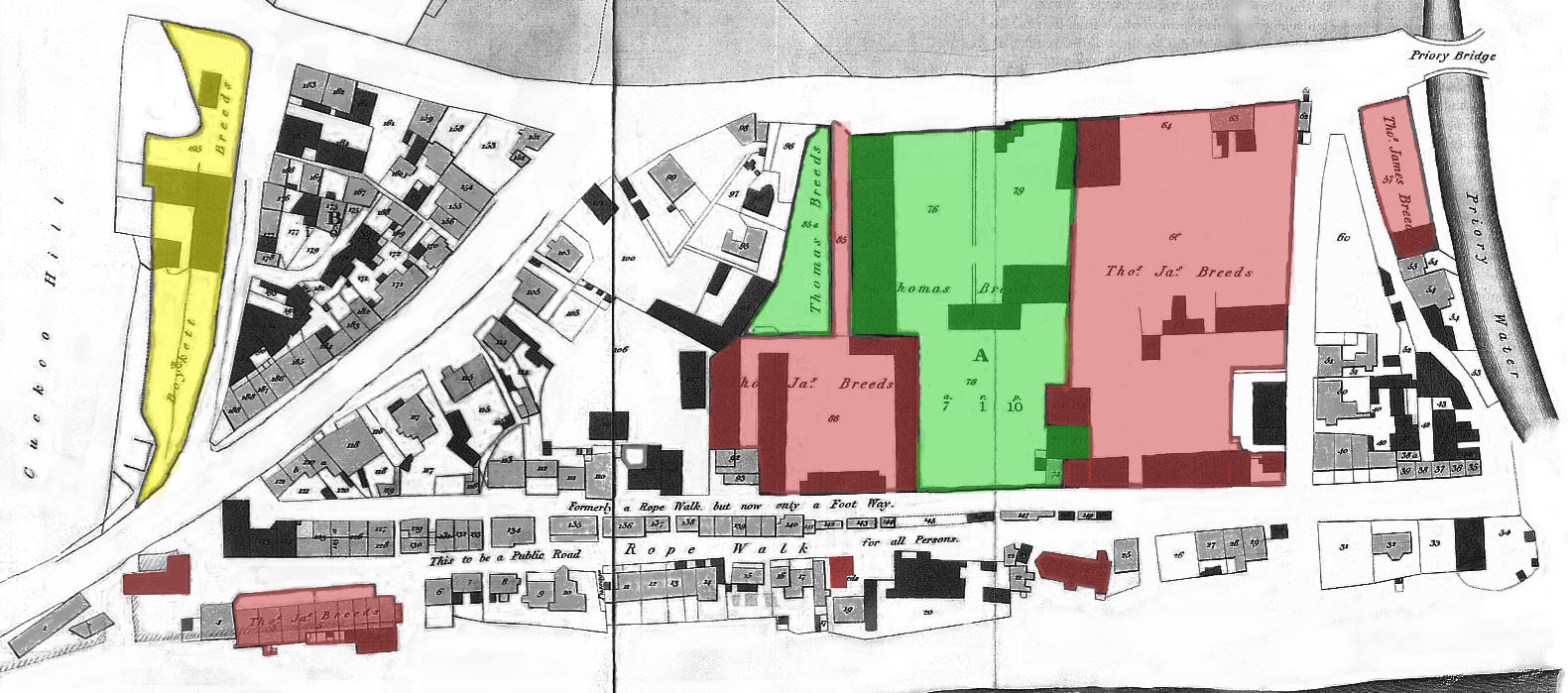
The America Ground in 1830. Cambridge Road is at the top. The coloured areas and buildings were owned/occupied by the Breeds family.
1822 - At this time of rapid town expansion, there was a great rush to squat the area that became known as the America Ground, the unclaimed land left by the sea, where Robertson Street is today. This 'No-man's land' in the Priory Valley lay beyond the Priory Stream, the western boundary of Hastings, and was therefore 'independent' of Hastings, in the same way that America had recently become independent of England. Contemporary local historian TB Brett said: 'It had gained the appellation of "America", primarily from the fact that it could only be directly approached from Hastings by going over the water [the stream], and, secondly from the corruption of Priory into Prairie.' He said that Hastings people had built there 'under the belief that as the land had once been overrun by the sea, and for a vast period had been left as dry and waste, there was no real owner of it.' In early May 1822 there was a fight between two of the squatters, with each pulling down the other's house. In 1821 the Crown had become aware of the existence of this area of occupied beach, and as the Crown owned most of Britain's foreshore - ie, land between high and low water marks - did the Crown own the Ground? A survey was carried out to examine the emerging problem, although no action was taken as a result.

The America Ground as shown in the 1830 map (above) transferred onto a map of today's Hastings town centre.
1822 July 16 - The first Wesleyan chapel to be built in Hastings opened. It was in Waterloo Place, off All Saints Street, and measured 42 feet by 38. The founder, the Rev Henry Beck, said that at that time 'smuggling was extremely rife - swearing and profane language shockingly common. ... Drunkeness and its sad train of evils abounded on every hand.' The second chapel, in Hollington, opened in 1825. In 1834 the Methodists bought the Hastings Theatre in Bourne Street and converted it into the Wesleyan Chapel.
1822 July 18 - An application by a comedian, Mr Sage, to build a theatre was rejected by the corporation. Similar applications by other people in March and October 1823 were also refused.
1823 May 12 - The large area of the former barracks at Halton was sold for £3,000 to the Breeds family for redevelopment, which took place some years later. The timber-built military buildings, covering 13 acres, had included a hospital, 18 stables, a canteen, store rooms, a barn, a granary, and a forge.
1823 June 2 - The foundation stone of the new town hall in the High Street was laid (until recently the Old Town Hall Museum). The ground floor was initially a market, opening on 25 October 1823, with 14 stalls: meat Wednesdays and Saturdays, fruit, fish, eggs etc other days, but closed Sundays. It became a police station and fire station. It replaced the 1700-built town hall - then in a 'very ruinous and decayed state' and not suitable for the expanding town - on roughly the same site, but set back from the road. The 1823 building was renovated in early 1848. The present town hall in Queens Road was built in 1881.
1823 Summer - After two years complex work, the last parts of the Gun Garden, the large cliff on the south-west side of the castle, were demolished to allow the future building of Breeds Place and Castle Street. The whole project had been very difficult, including firing shots with a cannon at the cliff, undermining with picks and shovels, and with horses and oxen hauling chains attached to the cliff. At least three men were killed. The garden had been sold by Edward Milward to Thomas Clarke for £2,110 in April that year.
1823 Oct 3 - The first annual horse race was held on a 1.5 mile course on the Bulverhythe Salts, near the sea. It was very successful, but the land was marshy and flat, making both the course and the viewing difficult, so in September 1826 the course was moved to the Filsham Valley, at the bottom of Filsham Road. This was much better, and the 6,000 spectators at the 1826 races had a better view from the surrounding slopes. The annual races every September remained very popular, but the last was in 1848, when South Eastern Railway bought part of the course for the line they were to build from Tunbridge Wells to Bopeep.
1823 Oct 30 - Death in Hastings of Edmund Cartwright, the inventor in Leicestershire of the mechanical loom for producing cloth that sparked the 1812 Luddite riots by workers fearing unemployment. The riots, confined to parts of the Midlands, were soon suppressed by thousands of soldiers, aided by a rise in job opportunities for the workers. The invention by Cartwright, born 1743, became an integral part of Britain's textile industry which helped clothe the world in the 19th century.
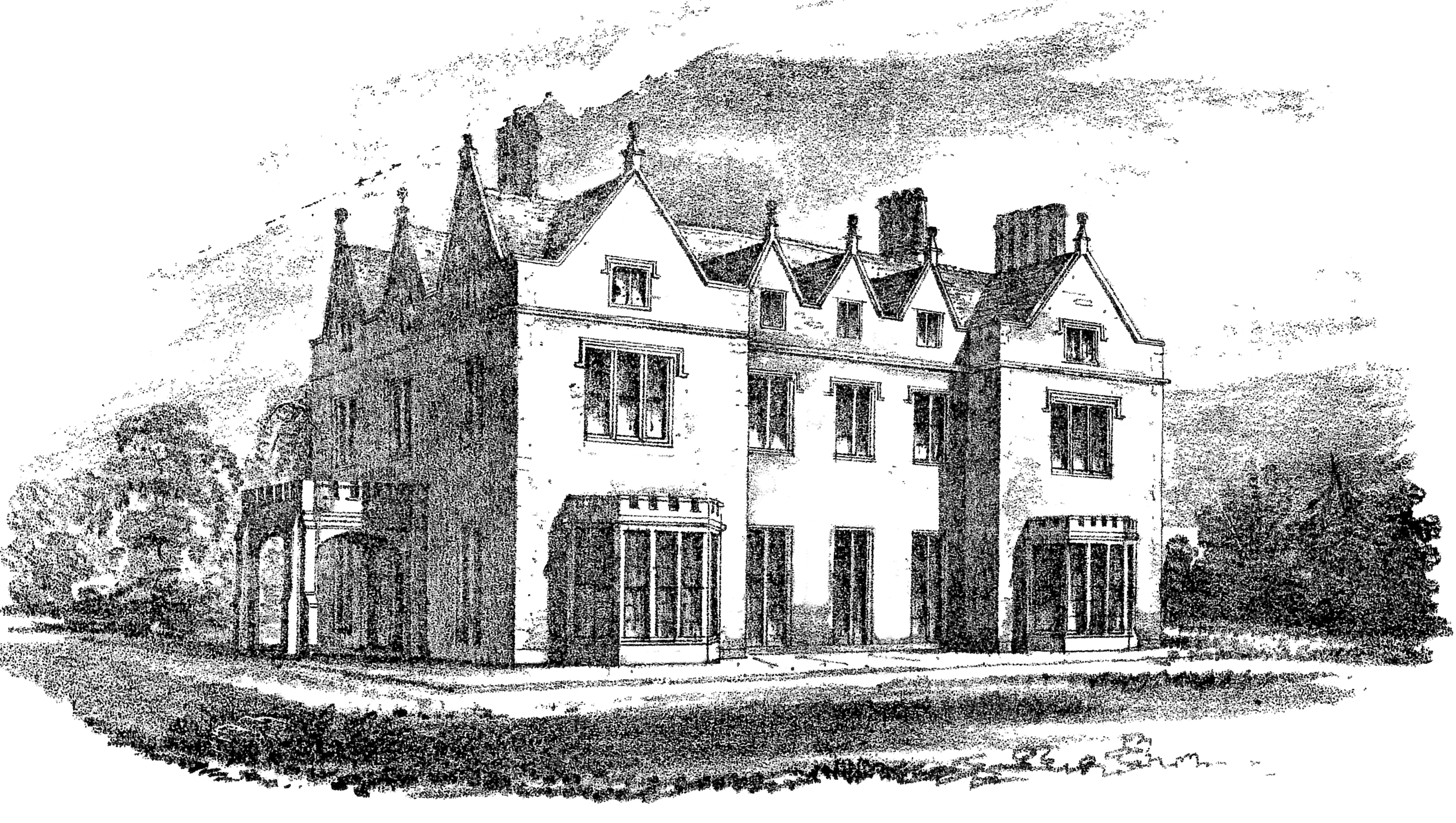
Bohemia House.
1824 - Bohemia farmhouse was rebuilt for George Collingwood by ‘Yorky’ Smith as the mansion Bohemia House (later called Summerfields). It had a large estate running south. It was bought by Thomas and Boykett Breeds, of the local merchant family, in late 1824 and then Wastel Brisco in 1831.
1824 - The first history of the town was published: The History of Hastings, by Mr WG Moss, who had come to the town to recover his health. The book's map showed the Bourne stream still open north of the Creek, and covered over to the south of it. There was a group of four windmills on the West Hill. The town had started spreading westward, as far as the Priory Stream, with development also taking place in gardens in the Old Town.
1824-28 - Pelham Crescent and St Mary in the Castle Church were built for Thomas Pelham, the Earl of Chichester. He owned Hastings Castle and the land along the base of the cliff in front of it, and from 1818 saw an opportunity to develop that land to house the new 'discriminating population' of Hastings. He first built Pelham Place, a terrace of seven large houses, just to the west of the end of George Street. Then he decided to extend the terrace to create Pelham Crescent and the church. By 1823 he had commissioned the well-known architect Joseph Kay (1775-1847) to carry out the scheme, which involved removing much of the cliff and a large part the castle. At the same time the Earl carried out a partial excavation and rebuilding of parts of the castle, which his family owned from 1591 to 1951. Below the castle, a semi-underground shopping arcade was built first, followed by part of the crescent of grand town houses above and behind the arcade. The arcade opened in mid-August 1825, although it was not quite complete. The centrepiece of the crescent was St Mary in the Castle Church, a proprietary chapel, the creation of which was given royal assent in May 1825. It was consecrated on 28 January 1828. The church's first incumbent was the Rev William Wallinger, who lived in Castledown House (now demolished), and its cemetery was alongside the commemorative Wallingers Walk, off Castle Hill Road. The east side of Pelham Crescent was completed in 1828, as was the terrace of six similar houses immediately to the west of the crescent, forming Breeds Place. They were built by James Lansdell, a Battle builder who married Martha Breeds of the influential local Breeds family. The church became parochial in 1884, and ceased being used as such in 1970. Hastings Council acquired it in 1990. Also in the mid-1820s a group of eight large houses called Beach Terrace was built on the beach in front of Pelham Crescent. The ownership of all the beach from the Old Town to the Priory Stream was uncertain, and members of the local establishment, in the form of Hastings Council, would give their mates permission to buy a space and build something on it, even though the Council could not prove it owned that piece of land. This happened with many properties built near the sea in this area in the coming years. Beach Terrace became the most controversial 'near-squat', however, as it stood directly in front of the crescent from which residents were expecting to have good seaviews. The terrace survived an early campaign to have it demolished and much battering by the sea through the 19th century, until it was removed for the seafront improvements around 1930.
Pelham Crescent as planned by Kay in 1824 - but the church was rather different when finished! Pelham Place is on the right.
1824 March 1 - The Sussex Advertiser reported that on February 23 the 'principal inhabitants of Hastings' held a meeting at the town hall and agreed that a 'certain number of watchmen, properly armed and accouterd' should be appointed 'for the prevention of a repetition of nocturnal depredations, robberies etc and for the protection of property in cases of fire or other accidents'. A force was raised by private subscription consisting of nine men. The 1820s were a time of high unemployment and a military crackdown on the smuggling industry in which many local working class people were involved. Robbing the large number of upper-class visitors and lodgers in the town was an alternative income.
1824 May 11 - There was a near riot on East Parade when Hastings Council officers tried to force fisherman Thomas Tassell to move his net shop down the beach. The Council were trying to widen the road, but Tassell threatened to chop off the hand of the first person to touch his building. Constables were called to keep peace, and later six men were arrested and charged with assault and riot. There were then about 60 rope and net shops on the Stade, but as the town attracted more tourists some of the buildings were being converted to retail shops and houses.
1824 July 14 - The worst combined thunder and hail storm for many years damaged property throughout the town.
1824 July 25 - A well-laden smugglers boat ran ashore at Cliff End, four miles east of Hastings, but before the landsmen could escape with tubs over their shoulder they were pursued by blockademen over the Royal Military Canal. Six of the smugglers - some wounded - drowned and another was shot dead.
1824 Nov 22 - There was a severe storm, causing much serious damage along the coast and seafront. The tide was the highest for many decades. Much of the property on the America Ground was destroyed.
1825 - Sir John Herschel took long-range survey readings close to where North’s Seat is today in order to help determine precise calculations for degrees of longitude.
1825 Feb - The Swan Hotel in High Street was sold. It had a large assembly room, a wine vault, 62 horse stalls, standing for 30 coaches and several properties adjoining.
1825 Feb 28 - Hastings Corporation banned the 'playing of marbles and hopscotch (or any other game) in the public streets, lanes and places'.
1825 June - Hastings Corporation agreed to number all buildings and name all streets in the three parishes.
1825 Aug 11- The new Pelham Arcade, under Pelham Crescent, was opened for the first time. There was an evening of entertainment after the popular annual races at Bopeep earlier that day. The new warm baths on the seafront opposite Pelham Crescent opened in early December 1825.
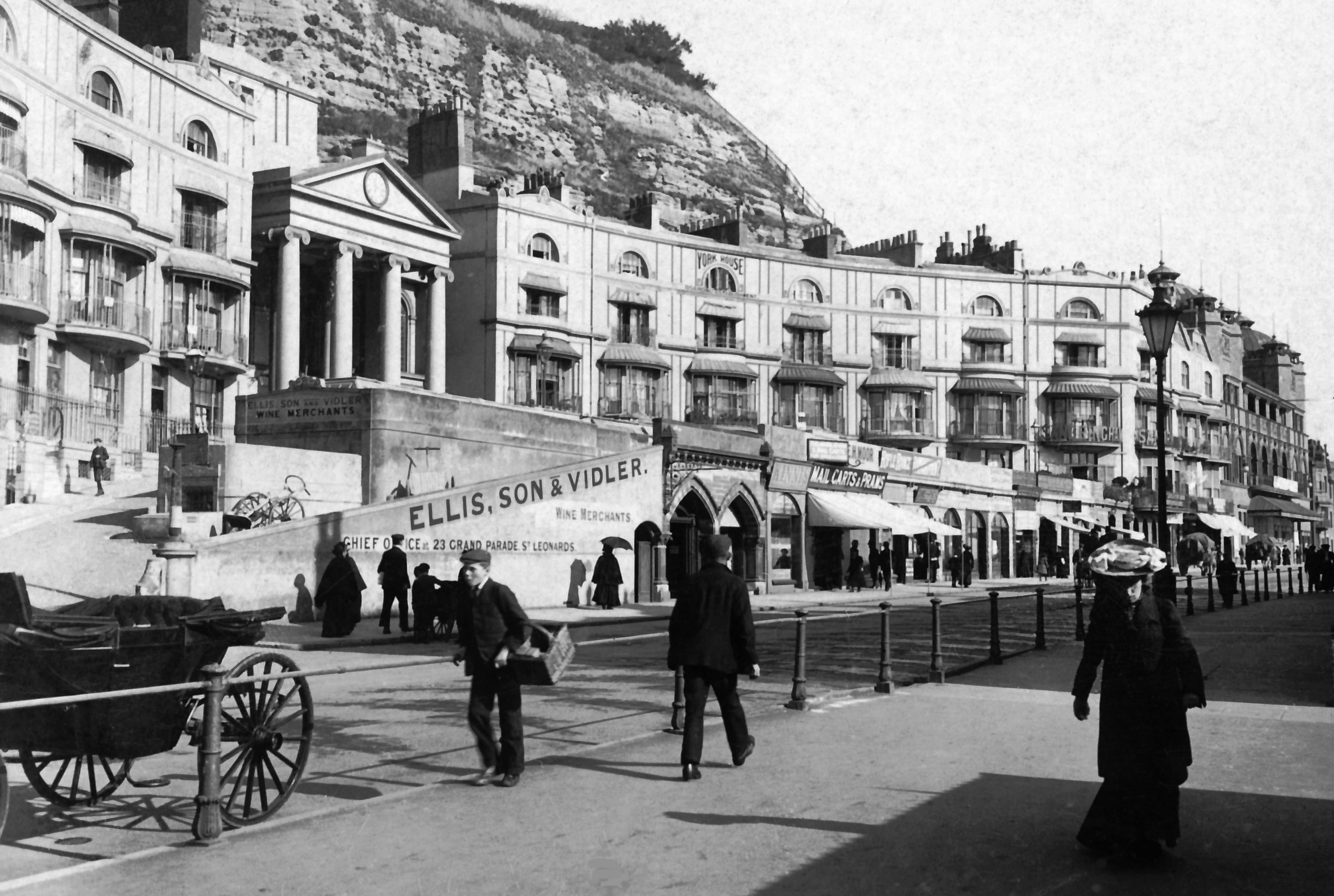
The completed Pelham Crescent and Arcade, as they looked in the early 1900s.
1825 Aug 18 - The New Theatre, the first purpose-built theatre within the borough boundary, opened in Bourne Street, at the junction with Courthouse Street. A licence had been given to Frederick Brooke, a comedian, to perform 'tragedies, comedies, interludes, operas, plays or farces'. The first play was 'As You Like It'. However the theatre was unsuccessful. In the autumn of 1830 it was redecorated and embellished, opening on 25 October that year, but it was less than half full on that evening, and it closed soon after. It was converted into a Wesleyan chapel in 1834.
1825 Dec 25 - There was a 'riot' early in the morning of Christmas Day, with the watchmen being assaulted. Five men were convicted and fined, but the main prosecution witness was attacked several times after that. Members of Hastings Corporation in February talked of 'a conspiracy now existing in this town to intimidate any person for giving evidence on penal or criminal proceedings'.
1825 Dec 28 - A serious disturbance took place outside the Town Hall in the High Street when the wife of a shoemaker, named Shawford, was attacked by a group of women she was accusing in court of illegally selling smuggled alcohol, a common practice in the town. She stayed in the hall for several hours afterwards, in fear of being attacked, which she was when she left.
1826 Oct - Part of the High Street was the first road in Hastings to have a ‘macadamised’ surface (a newly-invented mix of small broken stones and stone dust). This was successful and the rest of High Street and other roads soon followed.
1827 June 20 - Two mail coaches began to run daily from London to Hastings, drawn by four horses.
1827 July 28 - St Clements Caves under the West Hill were opened as a tourist attraction. They had been excavated for several decades by many people seeking sand for a variety of uses, especially glass making and building work. It is unlikely they were used for storing smuggled goods, as they were so well known. Owner Edward Milward blocked the entrance in 1811. But local greengrocer Joseph Golding later obtained a lease, built the current entrance, made the caves bigger and opened them to the public in 1827. There were repeated rumours of tunnels going to the windmills and Angel pub on the far side of the hill, with one tunnel known to be at the junction of Priory Road and Collier Road.
1827 August - The corporation agreed to replace the lower light house near the Cutter Hotel, which was in a 'ruinous state'. It guided fishing boats ashore, clear of the rocks. The new one (still in existence) was built close to the old site, but had coloured lights and reflectors to make it more visible amongst the growing number of other lights nearby.
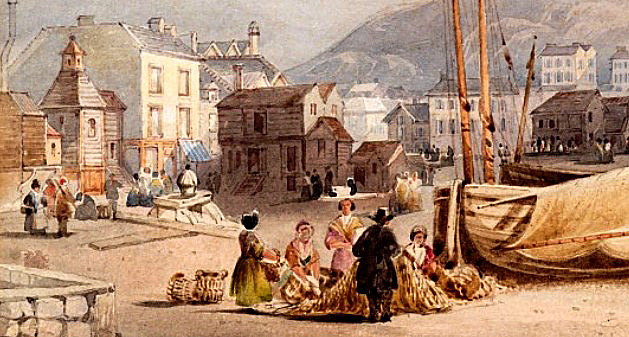
The 1827 lower light house, on the left, as seen in 1842.
1827 Dec 6 - The Crown held an inquiry at the George Inn, Battle, into the ownership of the eight acres of waste ground outside the Hastings borough boundary, between the Priory Stream and White Rock. It had been seized and built upon by many Hastings people who believed it had no owner. This new land had been thrown up by the sea during the late 18th century, and as Hastings expanded rapidly from around 1815 onwards many of the town's industries and workers took over the ground, especially from 1822. It became a 'no mans land' of perhaps a thousand people living and working in about 200 buildings - houses, sheds, workshops, stables, warehouses etc. The biggest ground holders were the Breeds family, occupying about a third of the land. They had built a 300 yards long ropewalk in 1800, and after 1815 added a shipyard, warehouses, shops, an inn and many dwellings. The eight acres were generally known as the Priory Ground, but its detachment from the local establishment drew parallels with the newly-liberated America, so it was also known as the 'America Ground', or the 'Hastings America'. However, there were many bitter and often violent disputes between rival 'squatters' over who owned pieces of the land, prompting the Crown to intervene, using the 1827 inquiry. There were actually four possible 'real' owners of the ground, apart from the Crown: Lord Chichester (holder of the Castle lands), Hastings Council (via the 1589 charter from the Crown), Lord Cornwallis (holder of the Priory estate, including the Priory Farm) and Sir Godfrey Webster. The inquiry was held in Battle, far away from the squatters, where the Crown, as judge and jury in the case, decided that it owned the land. In late May 1828 the Crown solicitor served notices on all those holding the property to prove they owned it, which none could do, and so, soon after that, all the occupiers were given temporary leases, with notices to quit by Midsummer 1835. The government's 'Broad Arrow' was placed on the buildings to signify state ownership. The ground was cleared from the autumn of 1835 onwards, and it remained empty until 1850, when work began on building today's Carlisle Parade, Claremont, Harold Place, Robertson Place, Robertson Street and Trinity Street. Many of the dispossessed land occupants moved in the early 1830s to the former barracks ground at Halton and to the new town of central St Leonards, even taking some or all of their building with them.
1828 - Work started on building the new town of St Leonards, the creation of London architect James Burton, who had bought what had been farmland from the Eversfield estate. He decided to build an upper-class seaside resort for the well-off people of London. On 27 February 1828 Burton paid £7,800 for part of Gensing Farm, with a frontage of 1,151 yards, and the first stone of the new town (the St Leonards Hotel) was laid on 1 March 1828. From 1828-30 he built the seafront (and the Archway at the east end), Crown House, Clock House, North and South Lodges and Maze Hill (west side). The town was built very quickly, and many of the hundreds of labourers and builders employed there lodged in the America Ground. The town's first shop opened on 5 December 1828. The hotel opened on 26 October 1829, and was renamed the Royal Victoria Hotel in 1834 following the visit of Princess Victoria to the town that year. 'Burton's St Leonards', as the town became known, provided few facilities and houses for the ordinary people it needed to service the town - builders, labourers, servants, horsemen, shop-keepers etc - and in the early 1830s a large working class suburb quickly emerged on the east side of posh St Leonards. This became what is now central St Leonards, with many of its first occupants being the former occupants of the America Ground. By 1835 many had moved to Shepherd Street, Norman Road, London Road and North Street. The creation of St Leonards opened up a new era in the history of the local building trade, with many builders becoming rich in the coming decades as both Hastings and St Leonards expanded, because both land and labour were cheap. For details of the early history of St Leonards, see www.burtonsstleonardssociety.co.uk.
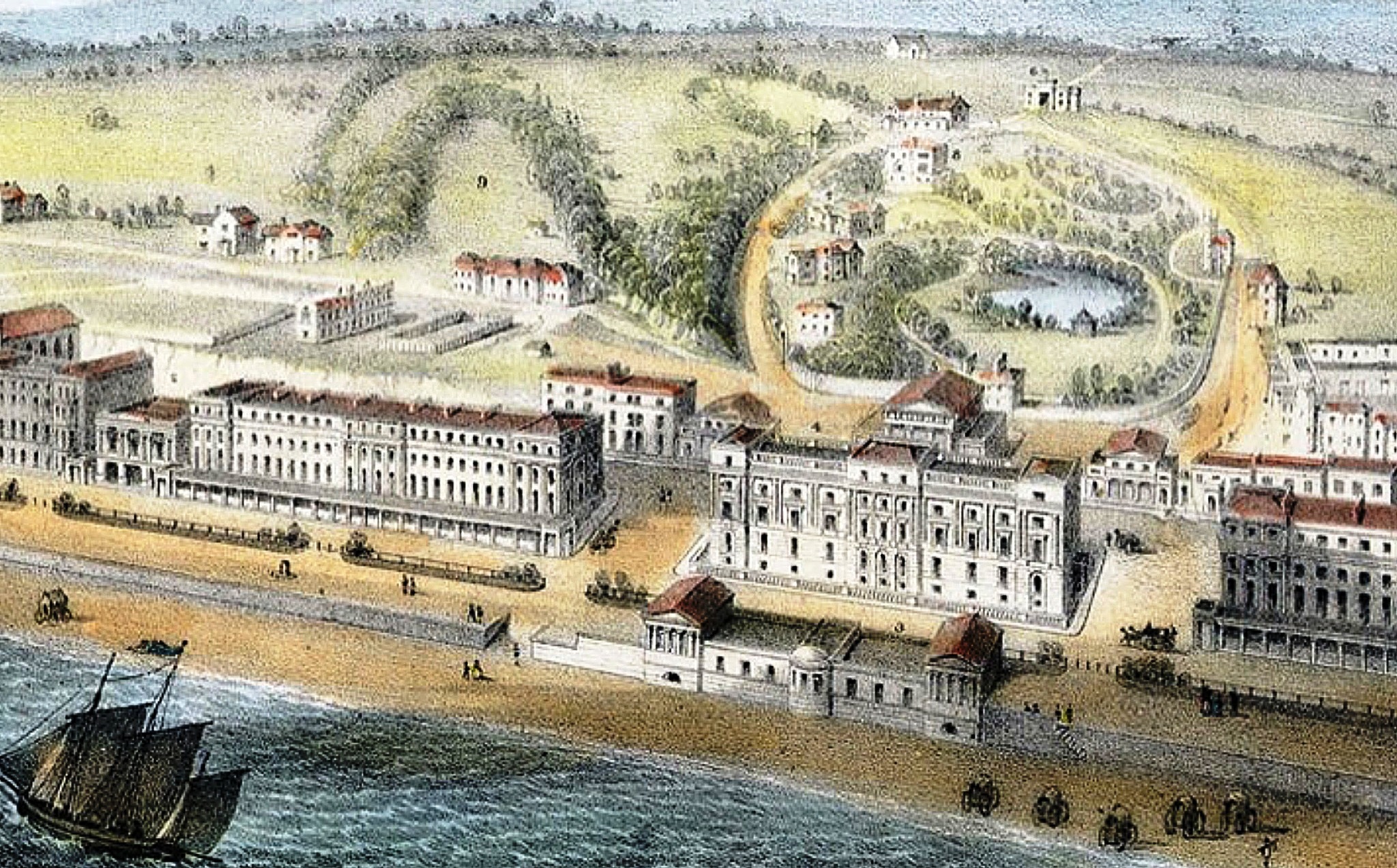
Burton's St Leonards, as it was planned to look in 1830.
1828 - The Hastings Brewery started in the Old Town. This was the town's biggest brewery, occupying an extensive site between Courthouse Street, High Street and Roebuck Street. It was owned by Thomas Breeds, part of the Breeds family which seemed to have been running a brewery on some of that site for many years previously. From 1810 (possibly earlier) the Breeds family also had the Phoenix Brewery, on the south side of Courthouse Street; it ceased being a brewery around 1908. By the late 1870s the Hastings Brewery owned 28 pubs and hotels, both in Hastings and the surrounding area, including the George Hotel at Battle and the White Hart at Guestling. In 1931 the family sold the business, which then had 35 licensed freeholds, plus warehouses, cottages and farms. The brewery finally closed in 1952, and much of its site has been redeveloped, although the remains of the engine house, with the bottom of its chimney, are still on the frontage of The Bourne.
1828 Jan 4 - A party of about 70 smugglers landed a cargo of spirits at Glyne Gap and set off inland with it. They and their 20 'batsmen' (bodyguards) were pursued in a running fight by 21 Coast Blockade men, who caught them at Sidley, where a battle took place. Two smugglers and a Blockade man were killed. The contrabanders all escaped, but eight were later caught, tried and deported.
1828 Jan 28 - The newly-built St Mary-in-the-Castle Chapel in Pelham Crescent was consecrated. Its large outside clock was completed in late October 1830.
1828 April 6 - Co-operatively-owned stores opened in Winding Street, probably the first such stores in Hastings. But despite having 160 members the business failed, as did others at later dates.
1828 May 5 - Eighty acres of 'Bunger Hill' (now called Broomgrove) in the Ore Valley were auctioned.
1828 Aug 14 - The very large sailing cutter Diligence, 171 tons, had been built for HM Customs at the Ransom and Ridley boatyard and was launched on this day.
1828 Dec 1 - Burglaries and robberies had become so numerous that on this day 160 inhabitants formed themselves into a body of nightwatchmen. But on the same night combustibles were placed against several houses and the windows broken.
1829 April 6 - On this day the first child was born in St Leonards, a girl named Emma, at 13 Marina.
1829 June 22 - Opening of Cavendish Place infants school, off Croft Road, the first infants school in Hastings. It was for children aged 2-7 years, who had to have short hair, and 'neat and clean' clothes. It cost twopence a week, paid on Monday mornings. The building still exists.
1829 Dec 9 - A public meeting agreed to start a free dispensary for the sick poor. It opened in an old house in Oak Passage at the bottom of the High Street in June 1830, the first hospital-like service in the town. In the first year 800 patients were admitted, with 657 discharged cured. It became known as 'the Old Town's own hospital'. The building was rebuilt in 1842 (and still exists).
1830 - The 1830 Beer Act made it legal for ratepayers to be given a licence to brew and sell beer on their premises. Many pubs opened in Hastings in the following years.
1830 Feb 20 - A large French lugger was wrecked at Fairlight. The ship’s boy drowned but the other ten crew were saved by men of the local Coast Blockade stations, for which the Shipwreck Institution gave their two lieutenants gold medals, and 16 guineas for the others.
1830 May 31 - A clothing club for the poor of the parish of St Mary-in-the-Castle was set up.
1830 Autumn - The town’s first gas works was built, on the site of the former waterworks, in Waterworks Road, off Queens Road, then a rural area with no nearby buildings. The town was lit by gas (82 lamps) for the first time on 31 December 1830. They replaced the oil lamps installed in 1820, being three times brighter. They were only lit from September to April, and not on the five nights around the full moon. The Hastings and Cinque Ports Iris of 8 January 1831 said 'Our once dark and dreary streets have the appearance of those of a fashionable watering place.' Gas was made from coal, which was brought to the town by colliers (small sailing ships) which unloaded onto the beach at Harold Place, from where it was taken to the works by horse carts. On 29 January 1831 the town's commissioners auctioned 'upwards of one hundred oak lamp posts, glass lamps, with burners, and irons to receive the same'.
1830 Oct 11 - The commissioners of the 1820 Hastings Improvement Act agreed to apply for a new Improvement Act, mainly because of the very bad state of the town’s water supply. This would give them the power to build reservoirs and lay pipelines. It would also enable them to erect a market, build sea defences and implement other measures. It came into force in 1832.
1830 Oct 23 - Launch of the politically radical Hastings and Cinque Ports Iris, the first genuinely local newspaper in Hastings – being owned, published and printed in the town. It closed in July 1831, after publishing number 37. It was strongly critical of the disappearance of town records that would have given more political power to the townspeople, so it campaigned for the parliamentary reforms then being sought nationally.
1830 Oct 24 - The famous Victorian botanical artist Marianne North was born in the Hastings Lodge (later the Sacred Heart School) in Old London Road, Hastings. She was the eldest daughter of the wealthy Frederick North, a Hastings MP from 1831-37 and 1854-64. The North family were prosperous landowners, supporting Marianne when she dedicated her life to painting flora. She was devoted to her father, and when he died in 1869 she decided to use her inherited money to travel the world painting as wide a range of flora as possible. In 1879 she told the Royal Botanic Gardens at Kew that she would like to build a gallery there containing her life's work. The Marianne North Gallery opened in 1882, and was restored in 2008-09 with a Heritage Lottery Grant of £1.8 million. The gallery contains 833 of her paintings.
1830 Nov - The Hastings Ladies’ Bible Association was set up by local gentlemen. They created a committee of women, which would advise other women that they would receive the 'most beneficial effect on the character' by 'visiting the cottages of the poor, and the abodes of the indigent, for the purpose of learning their necessities, and supplying them with that Book which is designed, by its Divine author, to be the directory of the poor as well as the rich'.
1830 Nov 3-4 - Serious disturbances broke out in the countryside around Hastings, being part of the Captain Swing uprising by impoverished rural workers trying to stop their conditions becoming worse. Many had also been involved in the profitable smuggling trade, which the government had been suppressing. The insurrection had started in eastern Kent in late August, and through the following months the new threshing machines became the main target of destruction. The Kent Herald said it was 'a war of poverty against property, of destitution against possession'. On 16 October the radical journalist William Cobbett had given a lecture at Battle, for which he was arrested, but later released. In early November the uprising mushroomed in the Hastings area, and was especially bad around Battle on the 3rd and 4th of November, with barns and ricks being burnt, and a large crowd surrounding the George Hotel. A high-class ball at the Swan Hotel in High Street on the evening of the 4th ended early on hearing of the fires. On 9 November farm labourers at Fairlight organised a meeting of all local farmers to demand a wage rise. On the same day, prior to the meeting, the labourers physically removed the Fairlight poor-house superintendent from the parish, with a halter round his neck, never to return. The farmers then thought it best to accede to the labourers' demands, and a decent wage rise was unanimously agreed. Other action in neighbouring parishes also won rises. Over following weeks Captain Swing spread around much of southern England, but the movement petered out in the summer of 1831. The upper class, however, felt so threatened by it that in the mid-1830s the Poor Law, giving aid to the poor, was made much harsher and the workhouses were turned into last-hope places of fear rather than help.
1830 Nov 4 - At the Swan Hotel in High Street, the first 'subscription ball' of the season for the local gentry began at 9pm, but ended early when news was received of the serious disturbances in the area.
1830 Nov 15 - Following a meeting at the town hall, a voluntary Night Watch (night-time police force) was set up in Hastings 'for the security and protection of the town' at a time of the increased crime and disorder accompanying the Captain Swing disturbances. The commissioners of the 1820 Hastings Improvement Act used the powers of the act to create the voluntary watch. Every night through the winter, 13 men were to patrol the streets of the town between the Priory Bridge and the Lodge in Old London Road. About 270 people backed the watch and volunteered to take part in some way.
1830 Nov 27 - One of 20 poachers was shot dead when they raided the Coghurst Hall estate of prominent local figure Musgrave Brisco. Brisco and his gamekeepers defended the estate, two miles north of Hastings, by fighting the poachers and threatening them with firearms, but they fired no shots. At the inquest on 1 December it emerged that John Woodhams had been accidentally shot dead by one of his companions. The jury brought a verdict of accidental death.

Captain Swing, with turpentine on his right arm, fire balls in his hair and gunpowder on his left foot.
1830 Dec - During the Captain Swing uprising, a 20-year old hoopmaker, Thomas Goodman, was sentenced to death for firing and burning a barn at Battle, being betrayed by his bootprints, but this was later commuted to transportation for life.
1830 Dec 4 - The local paper the Cinque Ports Iris said 'it appears as if the entire social system were at this moment not merely out of joint, but on the eve of dissolution, through being severed limb from limb by the midnight incendiary, or mobs of disorderly paupers. ... The ties which have hitherto bound society together are in many parts of the country dissolved.' It believed, however, that Hastings and the surrounding area were relatively peaceful when compared with other districts.
1830 Dec 24 - Magistrates in the Hastings and Battle area on 5 November had set up an expenses fund to help cover the costs of the Captain Swing rioting. On this day they reported that £1,908 (the equivalent of £175,000 today) had been donated, and asked for claimants to contact them in Battle. In mid-March 1831 the government distributed £500 (about £46,500 today) amongst witnesses who helped convict the arsonist of a barn at Battle.
1831 - The Hastings post office moved to 4 George Street. From 1829 it had been at 55 High Street, opposite the Swan, and before that, from at least 1824, at 53 High Street, on the corner of Post Office Passage. By 1854 Hastings had spread into the Priory Valley, so on 1 August that year the post office moved to 2 Wellington Place.
1831 - In this year, work began on erecting buildings to the east of the St Leonards archway on the, on land not owned by James Burton. The area became known as St Leonards-Without, and it was suggested that the whole area between the archway and Robertson Street should be known as the town of 'St Mary's', after the parish of St Mary Magdalen. The first to go up were 1-12 Grand Parade, where a graveyard and some military items were discovered (rumour had it that there was a 1066 connection, a burial ground after the battle). The development of what is now called central St Leonards took place almost as fast as had happened with Burton's St Leonards.
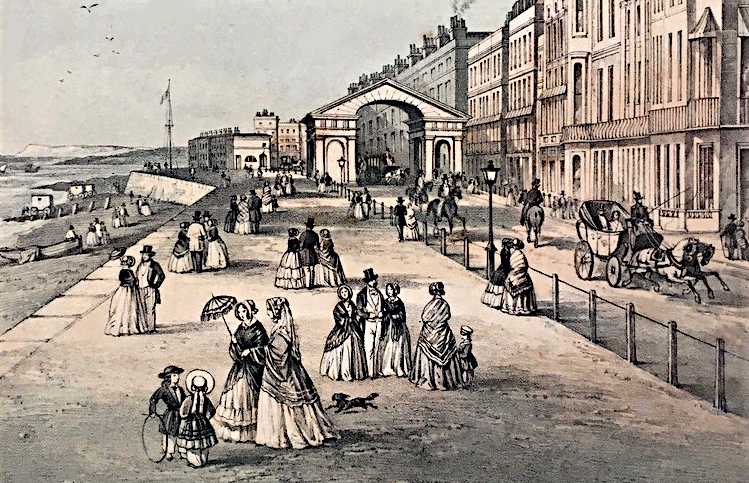
St Leonards-Without
1831 Jan 5 - Two smugglers - William Crittenden of Hastings and George Harrod of Guestling - were shot dead on the beach at Fairlight Glen by two Coast Blockade officers under attack from a large group of smugglers. A third, William Nash, died about ten weeks later from his wounds. The inquest’s jury decided it was justifiable homicide. Over a hundred tubs of spirits were recovered. Smugglers are believed to have played a leading role in the Captain Swing uprising that winter 1830-31. Contemporary local historian Thomas Brett said that smuggling was carried on to a greater extent and with greater risk around 1830 and for the next few years. On 8 March 1831 twelve horses and mounted patrols arrived to aid the Coast Blockade, plus 40 members of the Rifle Brigade later that year. There were many other smuggling incidents in 1831, and on 27 November two smugglers, one named Head, were shot dead at BoPeep.
1831 Jan 16 - A new piece of ground added to All Saints Churchyard was consecrated. It had been donated by Edward Milward.
1831 April 2 - The Hastings Fisherman’s Society was founded at a meeting of fishermen in the town hall. It was an insurance society for mutual benefit, setting up a permanent fund helping fishermen in times of distress. There were then about 100 fishing boats and 400 fishermen. The society survived, in run-down form, until the mid-1980s, when it was absorbed into the Hastings Fishermen's Protection Society.
1831 April 23 - The newspaper Hastings Iris said: 'We have received continual complaints from the visitors and inhabitants of the number of beggars which infest the streets of this town. We understand that among this alms-seeking tribe, Hastings is set down as a very snug retreat.' The Iris was 'convinced ... that begging is a fraud on the public, and that 99 out of a 100 of those who resort to it are not objects of charity.' In its June 18 edition it said there were 'swarms of beggars on the streets', and there were many other nuisances, but there was no police force to control things.
1831 May 18 & 19 - Several barns were burnt down in the neighbourhood of Hastings by incendiaries.
1831 Aug 21 - A large barn between Ore and Guestling belonging to Thomas Breeds, of Hastings, was set on fire by an incendiary. A man named Thomas Buffard was hanged in front of Horsham gaol on 31 December 1831, still protesting his innocence. Later the real offender confessed on his deathbed that he committed the deed while wearing a pair of Bufford's boots. The evidence that had turned the scale against Bufford had been given by the actual criminal himself.
1831 Sept 8 - The foundation stone of St Leonards Parish Church was laid at the west end of Undercliff by Princess Sophia of Gloucester. It was dedicated on 22 May 1834 and destroyed by a flying bomb on 29 July 1944.
1831 Dec - The Hastings Literary and Scientific Institution was set up with 33 members, aiming to provide a library, museum and lecture service. It was first based at 1 Burdett Place, off George Street, but it quickly expanded and became popular, so in 1836 two plots of land belonging to the old St Clement's workhouse were bought, and there the present building - now 42 George Street - was built. It opened in late 1838, with printer William Ransom (founder in 1848 of the Hastings News) leasing some of it. It was wound up in 1895 and the premises sold to printer Charles Clark.
1832 - The first regular local bus service started in 1832, or possibly slightly earlier, linking Hastings with the new town of St Leonards. The four-horse bus ran several times a day between the bottom of the High Street and the St Leonards Hotel. It survived for several years.
1832 - The 1832 Hastings Improvement and Waterworks Act came into force, giving commissioners wider powers than the 1820 Hastings Improvement Act, but without extending its coverage westwards to take in the parish of Holy Trinity and the troublesome America Ground. Also in 1832 a similar act - the St Leonards Improvement Act - set up a commission to pave, light and police the new town of St Leonards, and made St Leonards a separate local authority from Hastings. The Hastings commissioners were superseded in 1851 by Hastings Council under the Public Health Act 1851. This act set up a local Board of Health, which St Leonards managed to get itself excluded from. But the 1832 St Leonards act was dissolved in 1875, thereby merging the two towns.
Flooding at the Coastguard cottages off Bexhill Road (looking west).
1832 - As part of a revamping of the Coastguard service, a small single-storey terrace of six cottages was built where today is the east edge of No 345 Bexhill Road. The cottages housed men who were based in the nearby Martello Towers. The terrace was then the only significant building between the Bull In at Bulverhythe and Bopeep; Bexhill Road was a rough track.
1832 Jan 1 - A serious and violent smuggling encounter took place near London Road. Three of the 'free traders' were reported killed and several wounded, and several Coastguards were badly beaten by the 'batsmen' (the smugglers' bodyguards). A few days earlier the Revenge revenue cutter had seized a boat containing five men and 205 tubs. The men were locked up in No39 Martello Tower at Bopeep, but escaped on 5 January. Another desperate smuggling affair took place on 27 February at No 40 Martello Tower at Bulverhythe, in which two Coastguards were killed and two others injured. As the smugglers seemed well-trained and desperate, 36 dragoons and 40 riflemen were brought in to the town, but they did not stay long. The local feeling was that these servicemen were as ready to make friends with the smugglers as with the Coastguards.
1832 July 19 - A monster banquet was held in the Priory Meadows in celebration of the passing of the parliamentary Reform Bill, which widened the electoral franchise and aimed to make national government less corrupt and undemocratic. The bill was forced through parliament by the Whig (Liberal) government, which in November 1830 took power from the Tories for the first time in over half a century. In that month, a Hastings petition said that 'the whole government of the affairs of [Hastings], and of the elective franchise therein, was many years ago illegally and against the freedom of election usurped,' and had been ever since illegally kept under the control of 'certain individuals'. The Hastings Iris of 27 November 1830 complained that the illegality of what was taking place could have been proved by the town’s old records, but 'sacks full of them were burnt not many years since in a neighbouring town'. The first parliamentary election under the new law took place in December 1832. All three candidates were Liberal, with Frederick North and John Warre winning the two Hastings seats (Hastings had returned two MPs since 1369). There were 807 votes; in the last old-style election, in 1831, only 24 people had had votes. The 1832 Act gave votes to the male middle class - the better-off tenants and property owners, but not to the working class. North and Liberal Howard Elphinstone were returned in the January 1835 election.
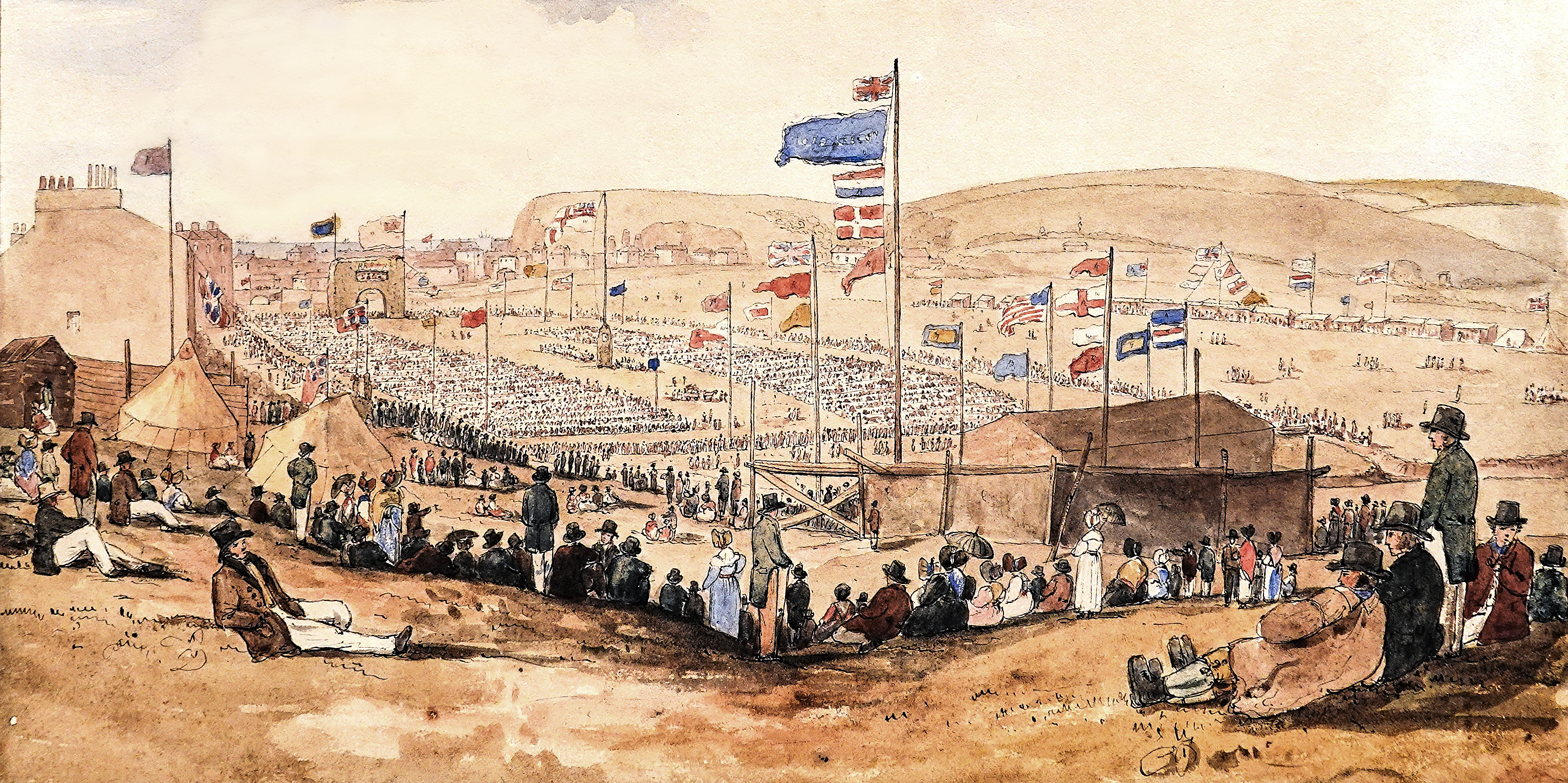
The 1832 monster banquet, looking from where Portland Place is today towards White Rock in the distance.
1832 December - The Board of Ordnance stopped using the 1760 battery on the seafront opposite the end of West Street, and removed its equipment. The Board retained ownership of the structure until late 1842, when it was passed over to Hastings Council, which then removed it and extended the parade over its site.
1833 Feb 12 - The new 100 ton collier-brig Lamburn was launched at the Thwaites and Winter shipyard. On the same day, or the 11th, the Thwaites collier-brig Coburg was run down by a schooner and sunk off the town while preparing to land coal at St Leonards. The crew were saved.
1833 April 8 - The Hastings shipyard Ransom & Ridley had built the 72 ton cutter Prince George for Prince George of Cumberland, and on this day it was launched from their yard opposite Wellington Square. In front of a large crowd, the Prince named the boat, which had six guns. William Ransom and William Ridley, both born 1770, had been in business together since at least 1801, and carried on into the 1840s. They were the biggest Hastings shipbuilding firm, constructing many scores of vessels, many of them of over 100 tons. The town's other large-scale shipbuilders were Thwaites & Winter, opposite Pelham Crescent, which also came to an end as the town expanded to the west, closing in 1843.
1833 April 23 - The Hastings Mechanics’ Institution was founded. It provided the first library aimed at ordinary working people, the Literary Institution being for the middle class. It was initially based in a schoolroom in Waterloo Passage, followed by George Street, before moving in 1839 to 39½ High Street, which had been built for it by Major Vidler.
1833 June 18 - The first meeting of the St Leonards Commissioners took place.
1833 Aug 7 - The new George Street Market, built by Hastings Corporation next to the Anchor pub, opened (and is still there). The corporation paid £3,550 for the properties on its site. It was intended to be the town’s fishmarket, replacing the open-air one on the beach, but fisher-folk strongly opposed this. Three fish sellers were locked up in the Courthouse Street gaol on 6 September 1833 for carrying on using the beach as a market-place, but a large group of fishermen released them by storming the building. The corporation then gave in to the fishermen, and allowed them to set up another fishmarket, close to where the old one had been. The meat market in High Street was then moved to the George Street market. Nine of the rioters appeared at Sussex Spring Assizes on 18 March 1834. They pleaded guilty, expressed 'contrition' and were bound over to keep the peace.
1833 Aug 12 - The first meeting of the Society of St Leonards Archers (later renamed the Queen's Royal St Leonards Archers) took place in what became known as the Archery Gardens in Archery Road. It had previously been a brick field.
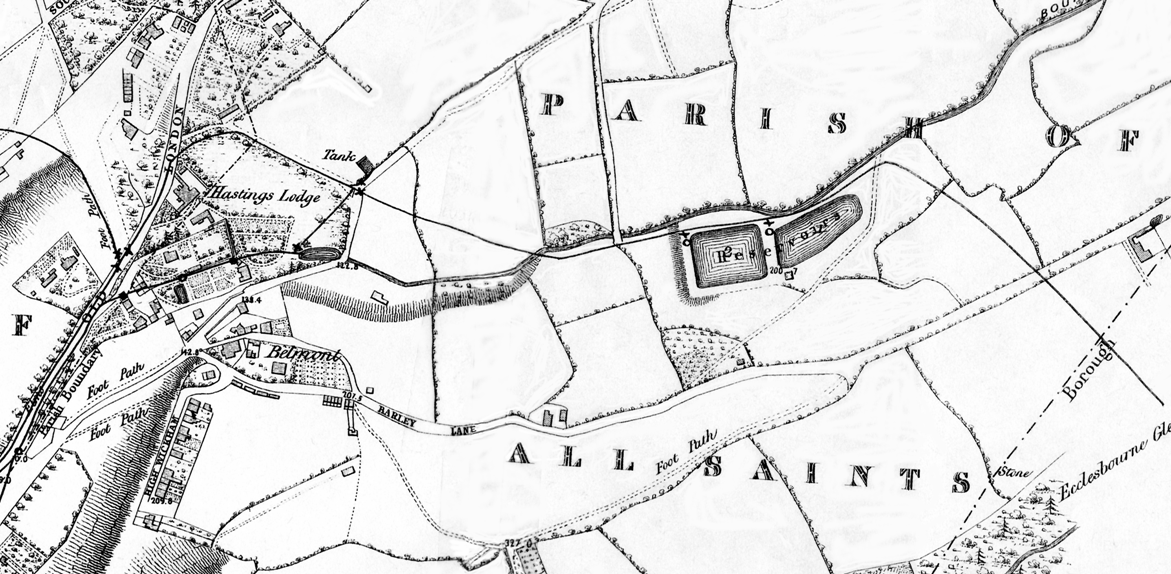
The two Clive Vale reservoirs, in an 1859 map. Harold Road did not exist then, and there were no houses in the area.
1833 Oct - Construction was completed of the town’s first water reservoir, in Clive Vale, and over the following months pipes were laid through the Old Town. It was initially called the Spring Field reservoir, it held 800,000 gallons, and cost £4,000. Houses could be connected to the pipes, for an annual rent, and two pumps 'for the gratuitous supply of water to the poor' were set up. By 1835 about 300 properties had paid to be connected, rising to over 533 by mid-1841. In the early 1840’s the reservoir was found to be too small, so a second one, holding two million gallons, was built immediately below it. This was completed by April 1844. Both still exist, off Harold Road, opposite Githa Road, and are used for angling.
1833 Autumn - Hastings Corporation tried to build its first groyne, 125 feet west of 'Rock-a-Nore Point', but it had to be abandoned because of storm damage. It was made of stone. In late 1834 the corporation built a wooden groyne there, instead. A groyne was needed because the first St Leonards groynes, built c1829, were depriving the Old Town of beach. Shingle quickly accumulated against the new groyne and in January 1835 a committee was set up to 'settle a plan and prepare regulations' on how to let all the ground east of Tamarisk Steps. Many fishermen needed to have sheds in which to house their weather-sensitive fishing gear, so the commission gave permission for them to build 'net shops' in strictly controlled rows, and no bigger than about eight feet square, for two shillings (10p) ground rent a year. This 1835 plan produced the layout of the net shops as they are today, but the annual rent has gone up to 25p! There were about 24 rows, in pairs, with spaces big enough to let boats be hauled up between the net shops in severe weather. This piece of town planning produced a unique collection of buildings which are all now listed as grade II* to preserve them. In Edwardian years there were about 110 net shops, with about 40 today.
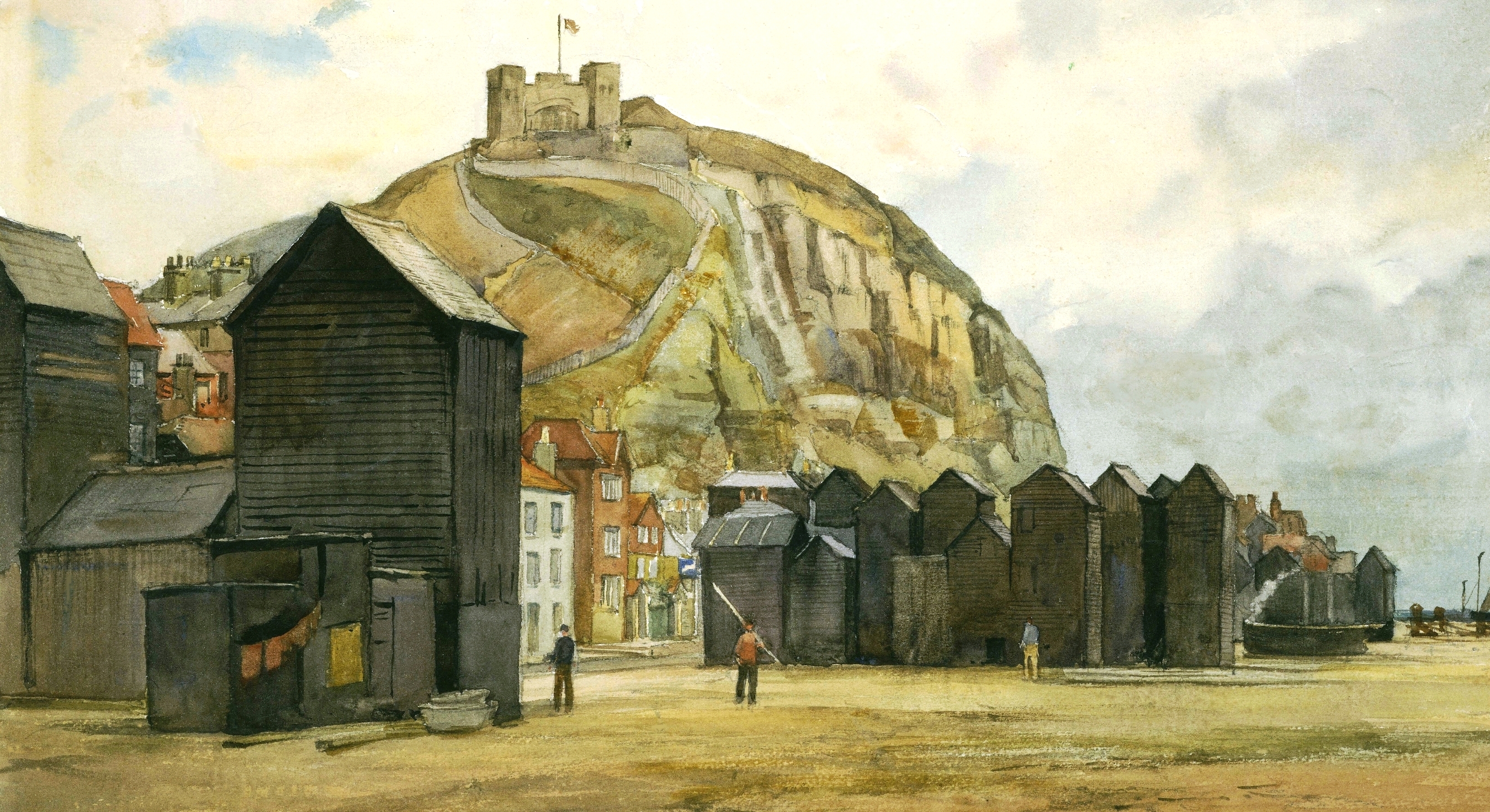
The net shops in the early 1930s, in a Leslie Badham painting. For the full story of the net shops, see the separate feature on this website.
1834 - The town bought its first large fire engine. It was housed in several places until a 'proper engine house', ten feet wide and 18 feet long, was built just to the east of Wellington Square. In late 1839 it moved to what is now the Stables Theatre at the top of High Street. There was a smaller engine, stored in St Clement's Church and then in 1842 in the town hall in the High Street.
1834 - The first National School in St Leonards opened, at St Clements Place, at the top of East Ascent. It cost £270, and the money had been raised at a Fancy Bazaar held in the Assembly Rooms in September 1833. Inside there were separate schools for the boys and girls, totalling about 70 initially. It was also the location of the Sunday School. There were several private schools in St Leonards at this time. It was a poorly designed building, and was replaced in 1847.
1834 May 22 - Consecration of St Leonards Church, originally called the St Leonards Chapel, just off the western seafront.
1834 June - The 1825 New Theatre in Bourne Street was purchased by the Wesleyans for £780 (one third of its cost) and converted into a chapel. It replaced their 1822 chapel in nearby Waterloo Passage.
1834 Oct 18 & 19 - A severe gale and high tide greatly damaged many buildings on the America Ground, forcing occupants to move elsewhere, and also undermined the buildings recently erected under the White Rock cliff. Further damage was caused by terrific gales on 18 December 1834 and 21 January 1835. The cumulative effect was to make the east end of what is now White Rock a narrow road, which was not widened for more than 40 years.
1834 Nov 4 - Princess Victoria, aged 15, came to St Leonards, staying at Crown House, 57 Marina, the first house built in St Leonards. She stayed until 29 January 1835, becoming queen in 1837. On 24 November 1834 she saw six Coastguards drowned when their boat overturned in front of 57 Marina while they were vainly trying to help the sinking Rye collier Good Intent. This prompted the building in a local shipyard of the first Hastings lifeboat Ariel. But the boat had no shed or crew, and saved no lives before falling into disuse about 1855. The princess allowed the St Leonards Hotel to be renamed in 1834 as the Royal Victoria Hotel, which it still is.
1834-35 - The Bourne Stream was covered over between the Creek and where the St Mary-Star-of-the-Sea Church is today. The stream had been running openly all the way through the Old Town to the sea until the early 1820s, being both a drain and a highly polluted water supply. In the mid-18th century the length south of Courthouse Street was confined to a channel with pavements on either side. Then in the early 1820s this section and the length north from Courthouse Street to the Creek were completely covered. The map in WG Moss's History of Hastings, published in 1824, shows the stream still open north of the Creek, and covered over to the south. In the winter of 1834-35 the long section north from the Creek to the south end of St Mary-Star-of-the-Sea Church was also covered, forming Bourne Walk. Also in 1835 the Slough pond at the top of the High Street was filled in. Many people in property adjoining the covered-in Bourne wanted it turned into a road, but most refused to pay any cost. The last open section of the Bourne, from the church to the junction of High Street and All Saints Street (known as the Wilderness because of its jungle of trees and bushes) survived until the building of The Bourne road in the early 1960s.
1834-35 - The White Rock headland was removed, allowing the building of a road under the cliffs (today’s seafront) to connect Hastings and St Leonards. The cut-back started at the end of Robertson Street, and by early 1835 construction was under way on several of the line of buildings now called White Rock. In the winter of 1834-35 several speculators, led by Charles Eversfield, whose estate owned much of the cliff-land between Hastings and St Leonards, funded the demolition with gunpowder of the headland. The rubble helped construct the new promenade and road, cutting back the cliff and building a sea wall from White Rock to the St Leonards Archway, which was completed in about ten months, in late 1835. Construction started immediately of the properties in front of the new cliff-face between White Rock and Warrior Square (not then built). But without the protection of the headland, the Priory Valley was flooded in following years. The cutback and the construction in 1836 of a new Coastguard station at Prospect Place (now homes) uncovered the remains of St Michaels Church, probably the town’s most important early church. The original pre-1066 town of Hastings was probably located on the White Rock headland, although most of the site has been lost to the sea. The Priory Coastguard Station replaced the one of that name that had been standing on the America Ground (today it would be on the promenade, opposite the middle of Robertson Terrace). The Priory is the oldest surviving Coastguard building in the borough.
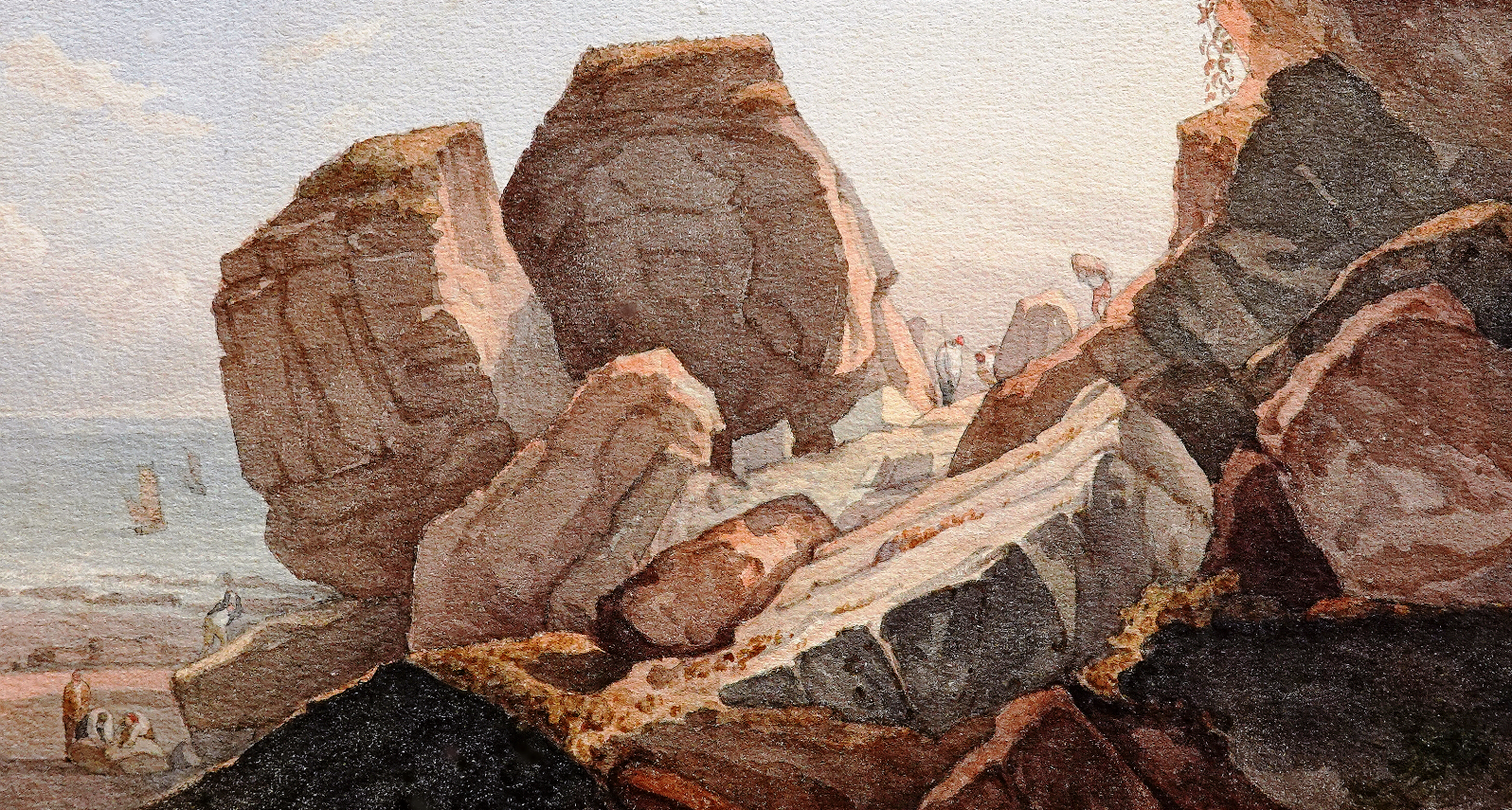
Demolishing the White Rock headland.
1835 - The Saunders charity opened a new school off Bourne Walk. The head was John Banks (1807-1882) who was to help found the Hastings Grammar School in 1878.
1835 Summer - There was a great drought causing much suffering to animals.
1835 July 22 - The 1834 Poor Law Amendment Act made life much harder for the poor by scrapping the 15,000 parish workhouses (often called ‘poor houses’) and merging the parishes into 643 unions. Each of these had to build a ‘union workhouse’, run by a ‘board of guardians’. The Hastings board had members from the 15 parishes in and around Hastings, and it held its first meeting on this day. It set about acquiring land for the union workhouse, which was built in 1836 and opened in July 1837 in Frederick Road, Ore. The nearest other union workhouses were in Rye, Battle and Hailsham. The 1834 Act followed the 1834 Report of the Commissioners on the Poor Laws, which said about Hastings: 'Population 10,097, divided into eight parishes. ... The population has increased very rapidly; the great influx of company gives a great deal of employment, particularly to women, as servants and washerwomen. The principal applicants for relief from the rates are the fishermen, a very improvident class of men, who spend all their earnings, whether large or small, and leave their families to the parish; there have been sometimes 200 families receiving relief; of late years the fishing seasons have been bad.'
1835 July 24 - Launch of the second local Hastings newspaper, the Hastings and St Leonards Journal, but it ran for only seven weeks.
1835 Sept - Following the radical parliamentary reform of 1832, the Whig government passed the Municipal Corporations Act to bring similar improvements to the structurally corrupt local government system in urban areas. Hastings was one of 178 boroughs listed as being run by a handful of money-making and unrepresentative individuals, with a tiny electorate. The 1835 reformed the 178 corporations by establishing a uniform system of municipal boroughs, governed by town councils elected by ratepayers. The boroughs had to puAct blish financial accounts and had to set up a police force. Councillors were elected for three years, and they (not ratepayers) could elect aldermen for six years. Until 1835 Hastings had been run by a small group of people whose legal basis for doing so was the 1589 Charter. From 1835 (the first election was on 26 December) the town was divided into two wards: East (the parishes of All Saints, St Clements and St Mary-in-the-Castle), with 12 councillors, and West (all other parishes), with six. Hastings therefore had twice the power of St Leonards. Plus there were six aldermen. The new system was more democratic than before, but it was mainly of benefit to the male middle class, as only the ratepayers had a vote. Although defective, the act laid the foundations of a way of running local authorities that proved generally acceptable. The 1835 Act only reformed the towns; similar changes in the counties were not brought in until the passing of the 1888 Local Government Act, which created East Sussex County Council.
1835 Sept 23-24 - Big horse races were held on the Filsham Salts, where the bottom of Filsham Road is today.
1835 Nov 16 - The first elementary school for boys and girls opened, at 57 All Saints Street, with separate entrances for boys and girls (still visible). It had been paid for by Mrs Sarah Milward (later Countess Waldegrave). As All Saints School, it moved to a new building in Harold Road, which opened on 1 October 1913 (now Dudley Infants School) and then to Githa Road in 1959.

The cleared America Ground in the late 1830s, seen from the new Coastguard station in Prospect Place.
1835-36 - The America Ground was cleared, ready for development. By 1835 many of its former occupants had moved, or were moving, to what is now central St Leonards, creating Shepherd Street, Norman Road, North Street and the bottom of London Road. This prompted the proper layout and construction of London Road to its junction with Bohemia Road. The 'squatters' often took their building with them, and at least 22 houses were built in St Leonards with materials from the America Ground. Some moved to Halton, and also created the nearby High Bank there, just north of Mount Road. In June 1836 Hastings Council sent a memorial to the Crown's Commissioner of Woods and Forests saying that the 'Priory Land' was then 'derelict and waste' following the Crown taking possession of it. The Council recommended it being laid out as a temporary park, there being no park in Hastings at that time, while plans for a harbour there were considered. In the spring of 1837 many local businessmen commissioned eminent engineer William Cubitt to produce a plan for a 40-acre harbour in front of the Priory Land and the castle. But this would be too expensive, so in 1838 Lt-Col Williams of the Royal Engineers was asked to produce a smaller 24-acre plan for one in front of the Old Town. But Hastings Council rejected the scheme because of the possible cost to ratepayers if it failed. The Priory land became known as the 'Desert' until development started in 1850.
1836-39 - Two different groups of business-people built rival turnpike roads to improve communications with London. St Leonards founder James Burton wanted a more direct route to London than via Hastings, so he was the leading force behind creating London Road, Sedlescombe Road South, Sedlescombe Road North, a bridge under the Ridge and the A21 to Whatlington, where it connected with the existing Hastings-Flimwell turnpike road. But the owners of that road were worried that Burton's road could lead to the loss of trade in Battle, so they upgraded Cambridge Road and Bohemia Road, and created Battle Road through to Beauport. These roads played a key role in shaping the layout of much of the north part of the borough. The coming of the railways in the 1840s quickly spelt financial disaster for the new roads, a failure that the St Leonards backers tried to avert by obtaining in 1841 one of the last turnpike acts from parliament. They had already built a branch road through Sedlescombe to Cripps Corner, and the 1841 act allowed them to extend this to Hawkhurst, from where travellers could reach Staplehurst on the London-Dover railway line.
1836 - The junction of the two new turnpike roads at what is now called Silverhill prompted the setting up of this suburb on what had until then been agricultural land. In 1836 the Tivoli Hotel/Inn/Tavern was built in the north gap of the junction, where Silverlands Road is today, and the area as a result was initially called Tivoli. The Tivoli Hotel was demolished in 1860, and while the surrounding area was being rapidly developed in the following years, the new suburb became known as Silverhill, probably taking its name from the long-established Silverhill Farm, located where Briers Avenue off Sedlescombe Road North is today.
1836 April 14 - The first stone of the new Priory Coastguard Station was laid in Prospect Place, on top of White Rock. Nine silver coins were put under the stone, but they were stolen the following night. The new station replaced the one that been on the America Ground, in the middle of today’s Carlisle Parade. The Priory Station, now residences, still stands on the corner of Prospect Place, looking much as it did when built. It is the oldest Coastguard building in the borough of Hastings.
1836 May 9 - The Hastings Police Force was set up, to replace the old unsatisfactory system of elderly watchmen. The first police station was a room in the town hall in the High Street, with its ‘watch house’ (with four cells) adjoining the gaol at the bottom of Courthouse Street. The force initially had nine constables, three sergeants and one inspector. The town was divided into three divisions: St Leonards (west of the Priory Bridge), Castle parish and the parishes of All Saints and St Clement's.
1836 Nov - Hastings Council had to start making plans for defending the seafront from increasing sea damage, following the removal of White Rock which had given protection, and the building of at least one groyne at St Leonards, which had stopped the longshore drift of shingle. Plus the Priory Stream and Bourne Stream were washing away shingle to the east of where they came into the sea. In coming months both streams had a hutch built at their mouth, and some groynes were erected east of the Priory Stream. A hurricane on 29 November was believed to be the worst storm of the 19th century, causing extensive damage. It destroyed the Brighton Chain Pier.
1836 Dec - A great snowstorm started on Christmas Eve; road communication with London was halted for ten days. More than a foot of snow fell and there were drifts of ten feet and more.
1837 - Launch of the Sussex Agricultural Express, renamed the Sussex Express in 1903. From 1853 to c1902 there was a Hastings edition called the Hastings & St Leonards Fashionable Express. In 1904 the Sussex Express was sold to the Hastings Observer publishers, FJ Parsons Ltd.
1837 June 16 - Ore Friendly Society was formed.
1837 July 10 - The new Hastings Union Workhouse received its first inmate. The fearsome large square building stood on the site of two cottages on the east side of Frederick Road (then called Cackle Street) in Ore Valley. It was near the bottom of the valley and was out of sight (and out of mind) for the better-off people in Hastings. It was renamed St Helens Hospital in 1948. Today much of it survives as private flats.
1837 July 13 - The lost toll was taken at the North Lodge Gate of Burton's St Leonards.
1838 - No 42 George Street was built, being the home of the Hastings Literary Institution, and a printworks.
1838 - One of the West Hill windmills was moved to Silverhill, standing on the junction of Sedlescombe Road South and what is now Windmill Road. It was destroyed by fire in February 1865, and another mill was then built there, along with a steam mill. The windmill fell out of use in the 1940s and was demolished in 1966. It was then the last windmill in the borough.
1838 May 8 - The new Baptist church on the south-west corner of Wellington Square opened. It had been built by Mr Joseph Fletcher, a shipowner of Limehouse, East London, in gratitude for his daughter recovering from consumption when brought to Hastings in 1836. The congregation had previously met at the assembly rooms in the Swan Hotel in High Street. The church is still in use today. In 1871 a Mission Hall was built at Halton; it was destroyed by bomb damage early in the Second World War.
1838 Aug 20 - The new Battle Road was officially opened. It was a turnpike road, linking Silverhill with Beauport, being part of the upgrading of all the roads from Hastings town centre to Battle and Johns Cross (and then to London). It included the creation of Cambridge Road as we know it today.
The new Cambridge Road winds its way up the hill, c1840. The America Ground is still empty, awaiting development.
1838 Sept 8 - Launch of the weekly newspaper the Cinque Ports Chronicle, which was published in Hastings. It had a traumatic life, changing hands and coverage several times until April 1841 when it was renamed the London and Southern Advertiser after being sold to a London publisher. By then it had ceased to be a Hastings paper.
1838 Dec 11 - St Clements Church, Halton, was consecrated. It was built with funding mainly from Mrs Milward. It was extended in 1888 and demolished in 1970. Its graveyard survives, on the corner of Egremont Place and Priory Road; the church and vicarage were on the west side of the graveyard, where houses are now.
1838 Dec 28 - A public meeting called by the mayor discussed a proposal to build a railway line from Hastings via Lewes to link with the London-Brighton line, then under discussion. Another suggestion was put forward for a line via Rye to the London-Dover line at Smarden. The meeting voted to support the building of a line in principle, without specifying which one. In February 1839 two railway companies placed adverts in the press saying they would be applying for acts of parliament to build lines to Hastings.
1838-39 Winter - The Priory Stream was culverted from the Priory Bridge to the sea, running under Harold Place. The bridge was then removed and the marshes drained, allowing development to take place in what was to become the town centre from the 1850s. A pedestal with three lamps was put up on the site of the bridge in late 1839, and the old track from the bridge to White Rock was improved, making it the basis for Robertson Street when it was created in the early 1850s.
1839 - The tithe map for the parish of St Clements shows that almost all the West hill was owned by Sarah Milward (Countess Waldegrave). It also shows there was a windmill on the west corner of Priory Road and Croft Road (now part of Tower House), owned by Charles Coleman, who rented from Milward the land now forming the Bembrook allotments, Collier Road and the adjoining south side of Priory Road. This land was used as meadows.
1839 - The local HM Customs swapped the lease of their condemned yard (for cutting up the boats of smugglers etc) on the beach opposite Pelham Crescent measuring 105’ x 27’, for a new site, 50’ x 30’, at Rock-a-Nore under the East Cliff, which was less of a public eyesore. In September 1852 they surrendered that yard, as smuggling had greatly declined in the 1840s, and its site is now that of the Fishermen’s Museum and the Shipwreck Heritage Centre.
1839 March 13 - The foundation stone of 39½ High Street, the new home of the Hastings Mechanics’ Institution, was laid by Frederick North, the president. The architect, builder and owner of the building was Major Vidler. The Institution was formed in 1833 and had been based in nearby Waterloo Passage, then George Street. It opened in October 1839.
1839 Dec - Work began on laying the foundations of the Hastings Infirmary at White Rock (where the White Rock Theatre is today). This was to be a hospital for the better-off people of Hastings, compared with the dispensary for the sick poor that had opened in 1830 at the bottom of the High Street. It was on a site purchased from the Eversfield Estate for £300. The people who ran the dispensary feared the infirmary would take away the donated funds which they relied on.
1840 - The Boys British School was founded, in a room under the Baptist Chapel in Wellington Square.
1840 Jan - An earthen vase containing about 30 brass Roman coins was reported to have been found inside ‘St George’s Churchyard’ (today’s picnic site) on the East Hill.
1840 Jan 21 - Birth at 3 The Croft of Sophia Jex-Blake, a physician and a leading campaigner for medical education for women. She became the first practising female doctor in Scotand and helped establish the London School of Medicine for Women. She died 7 January 1912 and is buried at Rotherfield.
1840 Feb 19 - The Cinque Ports Chronicle referred to 'Mr Strickland’s steam flour mill at the White Rock, which is the first steam engine erected in Hastings for mechanical purposes'.
1840 May 20 - Founding of the first Hastings Cricket Club, with its ground on the West Hill, where Collier Road is now. For many years prior to this the game had been played on the East Hill, the West Hill and other places.
1841 - The high wall across Norman Road that had been the eastern boundary of James Burton's St Leonards was demolished because it was a serious impediment to all traffic except pedestrians. The wall ran northwards from the cliff edge, across the road, along the east side of the Lavatoria houses and up what is now Kenilworth Road. The wall had been a barrier between the upper class Burton's St Leonards on the west side and the proletarian central St Leonards on the east. The removal of the wall was a recognition by the better-off westerners that they needed the services of the lower classes for cleaning, cooking, labouring etc
1841 Feb 5 - The big Hastings fishing boat, the Three Brothers, was lost off Start Point, south Devon. The crew of six were all drowned: Thomas Coppard (master), William Coppard (master's son), John Phillips, William Simmons, Ed Bumstead and Thomas Swain (boy).
1841 March 5 - A local branch of the Shipwrecked Fishermen and Mariners’ Benevolent Society was formed at a meeting in the town hall.
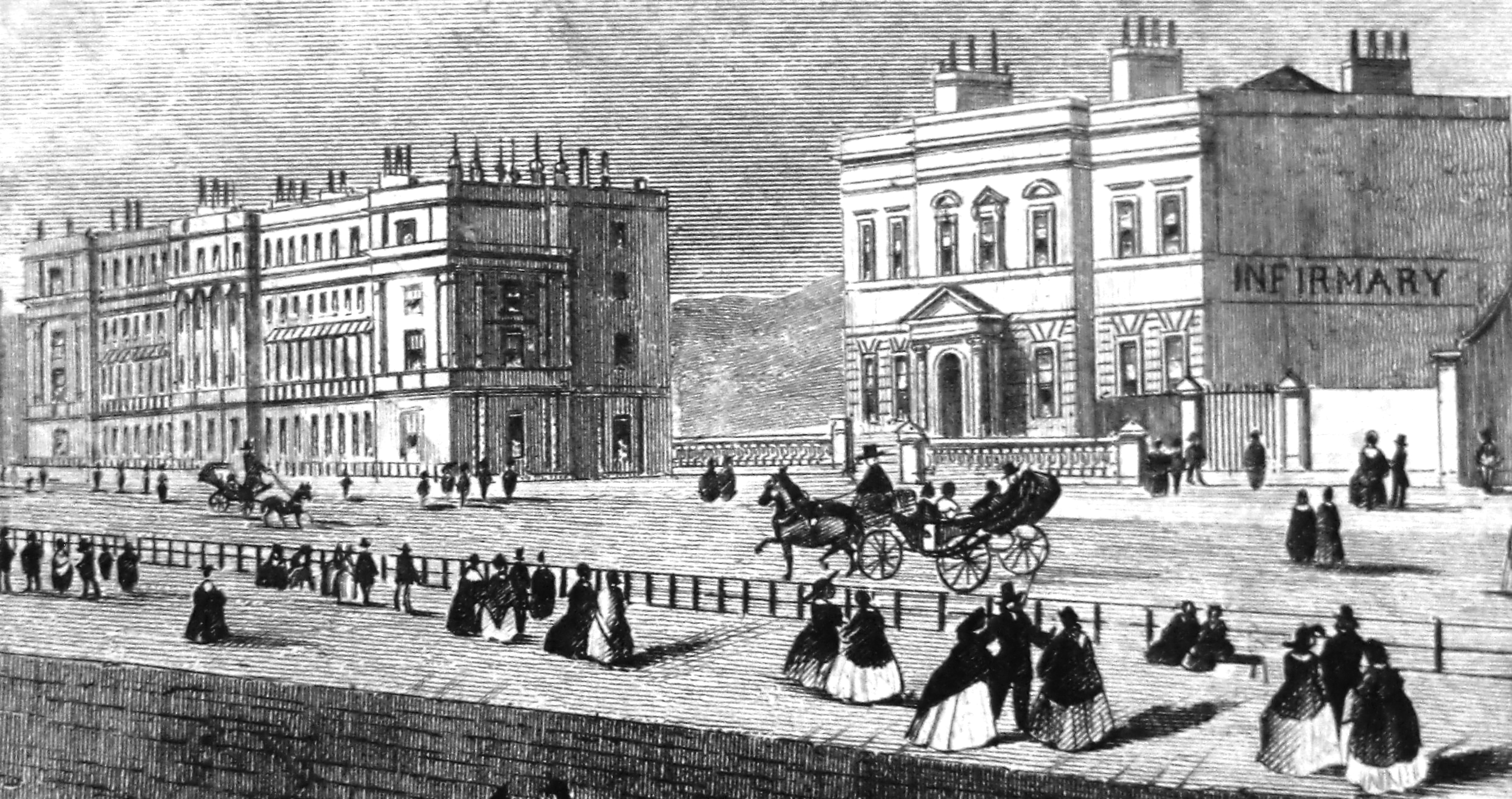
The White Rock Infirmary.
1841 June 24- Opening of the new Infirmary (a form of hospital) at White Rock, where the Theatre is today. It was a much larger building than the Dispensary in the Old Town, and more for the benefit of the middle class. Construction had started in December 1839. A wing was added on the eastern side in 1868. It was replaced by the East Sussex Hospital on the same site in 1887.
1842 April 11 - A meeting was held to start the Hastings and St Leonards Horticultural Society. Its first exhibition was held that July, in the Pelham Arcade.
1843 - A road was laid out across the rough ground of the then-empty America Ground, improving the connection between the Priory Bridge and White Rock, the main route westward from Hastings. The road was named Robertson Street when buildings were erected in the 1850s.
1843 - The passing of the 1843 Sea Fisheries Act tried to defuse the great hostility felt towards French fishermen, who had fished inside British waters on a large scale since the end of the Napoleonic wars. The act set up a three mile national limit, and required the official registration of all fishing boats at the nearest Customs-recognised 'port', which was Rye for Hastings boats. This was much to the annoyance of Hastings fishermen, who believed Hastings should be the official port. Initially the registration letters were 'RE', being the first and last letters of 'Rye'. Along with the letters, a number also had to be painted on the hulls of all boats, and as a concession to the Hastings boat owners, they were allowed to add 'Port of Hastings'. The letters RE clashed with other ports, such as Ramsgate, so the 1868 Sea Fisheries Act ruled that the port of Rye letters (and therefore the Hastings boats) should be 'RX', being the first and last letters of 'Rye, Sussex'.
1843 - A 'large and substantial stone groyne', 350 feet long, was built 'on the extreme point called Rock-a-Nore Point', about 280 feet east of the wooden groyne. The aim was both to protect the Old Town from the sea, and to increase the size of the beach for boats to lie on. But in mid-1844 its height and length were increased because of recent sea damage to boats and buildings.
1843-44 Winter - Forty unemployed men were paid by subscribers to lay a pavement on the east side of Old London Road, from the High Street to Mount Road.
1844 - The New England Bank pub at Bopeep was taken over and demolished in 1845 to make way for the Brighton railway that was to open in 1846 (cf). The last tenant of the pub, William Payne, then built nearby the Railway Terminus Inn, later renamed the Bopeep Hotel. The name 'New England' probably comes from 'new inning land', meaning land claimed from the sea, which had a bank on which the pub was built.
1845 - A new reliable and substantial Hastings guide book, the Handbook for Hastings and St Leonards, was published, by William Diplock, then proprietor of Barry’s old library (second edition 1864).
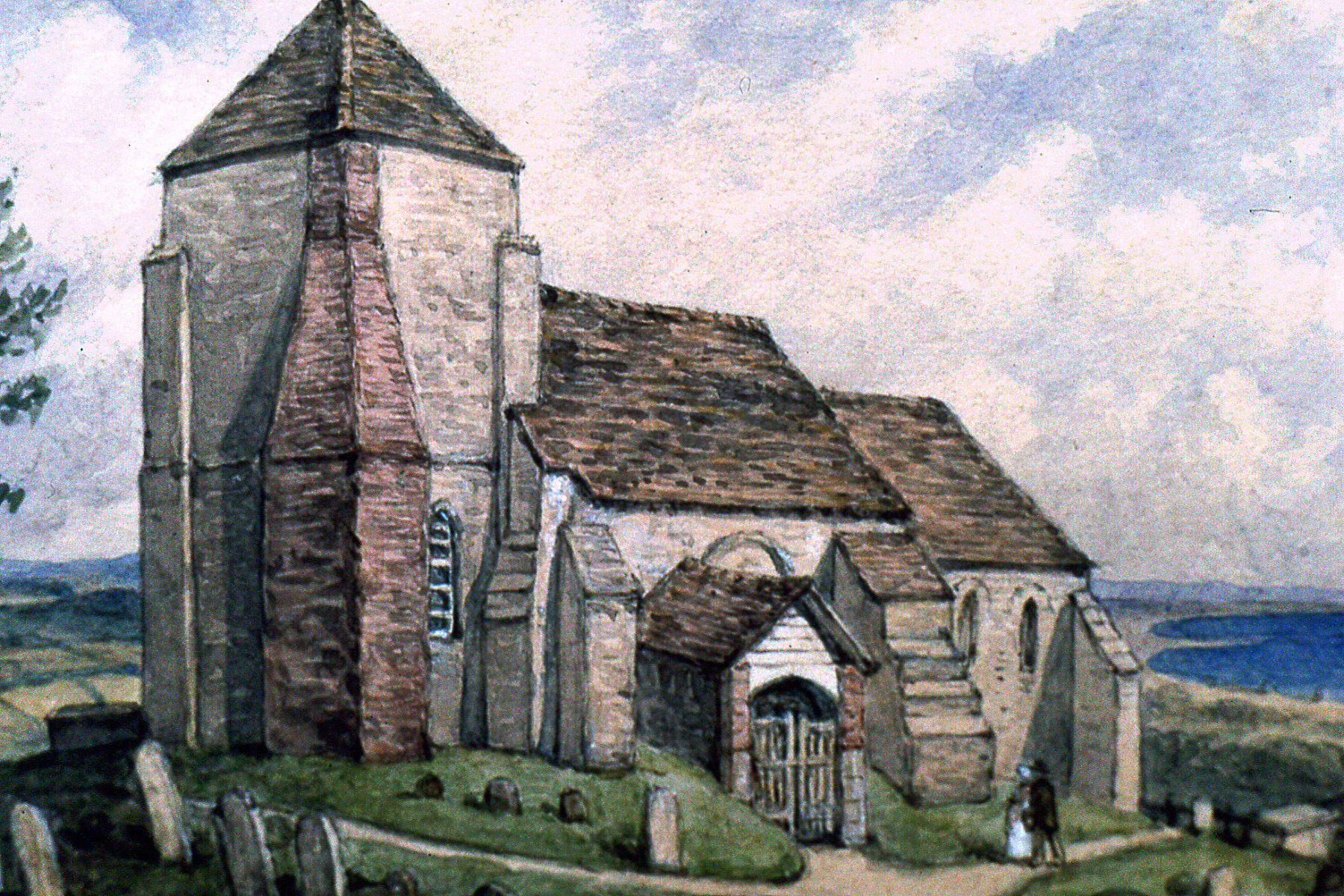
The 12th century Fairlight Church demolished in 1845.
1845 Spring - The small old Fairlight Church, believed to date from 1180, was demolished because it was in danger of collapse. The foundation stone of the new St Andrews Church was laid in May 1845 by Sarah Milward who had donated £1,000 to it, and was consecrated on 7 August 1846. Buried in the churchyard are Countess Waldegrave and her husband, members of the Lucas Shadwell family, the famous musician Richard D’Oyly Carte and the parents and sister of Cecil Rhodes, founder of Rhodesia (now Zimbabwe; some of the family lived at Fairlight Place for a while).
1845 July 26 - The Sussex Agricultural Express of this date said under the heading 'Hastings' that the first iron boat built in Sussex had just been completed by 'an ingenious mechanic named Frederick Lane'. It was built for pleasure, rowing and sailing, and the iron was galvanised.
1846 Jan 12 - A fire destroyed about 20 net shops and their contents of nets and ropes at the bottom of All Saints Street, the largest fire on the Stade on record. The fire was caused by fisherman William Adams, who had fallen asleep inside a net shop with a lighted pipe beside him. A fund raised enough money to replace the lost net shops, and there was enough excess to set up the 'East Well', a water tank along Rock-a-Nore Road. This harnessed a spring coming out of the cliff, which was the only clean free water supply on the east side of the Old Town, heavily used by fishermen. it was finished in March 1849. The Well exists today, but the water comes off the mains.
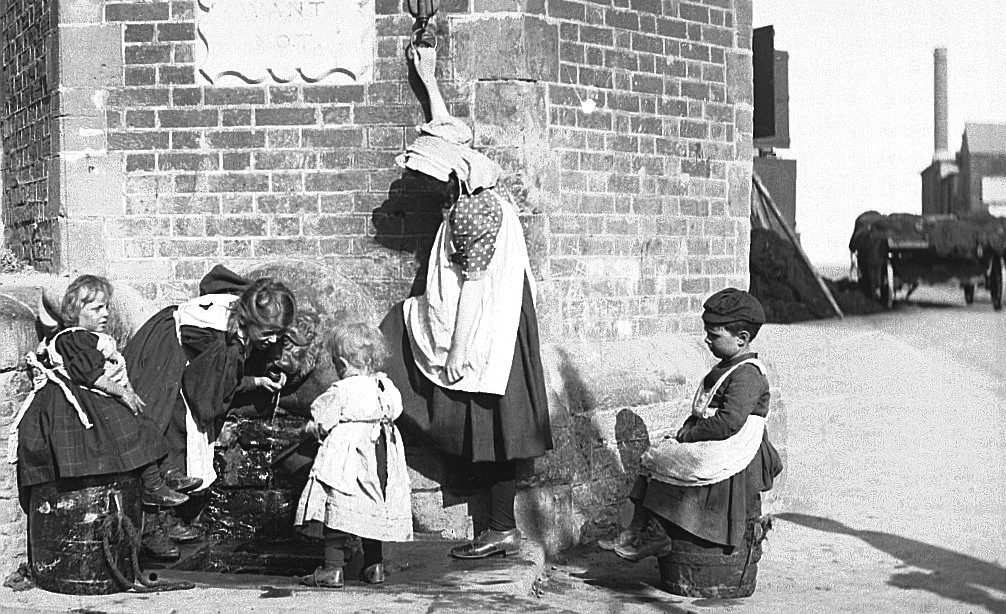
Having a drink at the East Well in the 1890s.
1846 June 27 - The railways arrived in the Hastings area, with a public service beginning this day on the line just built by the London, Brighton and South Coast Railway (LBSCR), from Brighton through Lewes to a temporary station at Bulverhythe, just to the east of the Bull Inn. There were big celebrations on the day, with bell-ringing and fireworks. A three-horse omnibus ran from here through St Leonards to Hastings. Work had begun at Bopeep on 3 January 1846 cutting the cliffs and filling the hollows at Bopeep, and the line was extended on 7 November 1846 to the new West Marina Station, a few yards west of the Bopeep Inn. The station was on the site of the demolished New England Bank pub, and was the nearest station to Hastings until the Hastings Station opened in 1851. It closed in 1967 and was itself demolished. The tunnels from here through to central St Leonards and Hastings had not been built in 1846. South Eastern Railways - a rival company to the LBSCR - was due to build the next line, from Bopeep through Rye to Ashford, and work started on the Bopeep-Warrior Square tunnel in August 1847, but stopped three months later, and did not resume until February 1849 (cf).
1846 Oct 21 - The large Hastings fishing boat Albion was lost near the North Foreland, Kent, along with its crew of seven men and one boy.
1847 May 29 - The new St Leonards National School opened, replacing the 1834 school at the top of East Ascent.
1848 - The tithe map for the parish of St Mary-in-the-Castle shows three windmills close together in today’s Gordon Road/Plough Inn area on the West Hill. In September 1849 a steam flour mill came into use adjoining the mill where the junction of Gordon Road and Priory Road is now. It was built by Mr TN Ward, of Ore.
1848 May - Teacher John Banks took over the mastership of Parker school and built new premises: Bleak House, at the southern end of Stonefield Road. This was a house with one large schoolroom, for 80 boys. This soon became the leading educational establishment in the town, and the birthplace of the Hastings Grammar School in 1880.
1848 May 1 - Launch of the new 10 ton pleasure yacht British Lion from the shipyard at Caroline Place, becoming the largest public pleasure boat on the beach. Built for Messrs Payne and Bumstead.
1848 May 1 - Mayday was celebrated around the town, with the 'shovel and broom gentry' in their 'annual bal masque'. A wide range of characters, including Jack in the Green and the 'characters of the soot bag', were 'tripping it on the light fantastic toe'.
1848 May 5 - The first long-living Hastings newspaper was published for the first time. The Hastings and St Leonards News, based in 42 George Street, cost 3 pence. It was published initially by William Ransom jnr, but that August he became ill and his father, William Ransom snr, took over. It had high standards and was openly Liberal (thereby challenging the Conservative Hastings establishment). It set the agenda for Hastings newspapers for a quarter of a century, in a market it dominated alongside the Hastings and St Leonards Chronicle until the rise of the Hastings and St Leonards Observer in the early 1870s. The News closed in 1905 at the height of the economic recession.
1848 May 12 - A letter in the News claimed that people could live in Hastings unemployed for the 7 or 8 months of winter, thereby attracting 'the idle and ill-disposed to make our town their home'. Many other letters in coming weeks echoed these sentiments. Hastings magistrates on this day gaoled a man for a week for begging. He was in a 'miserably ragged condition', with one foot bound up, and his head 'all in an uproar'.
1848 May 25 - The newly-built National Schools opened in St Leonards.
1848 May 26 - The News of this date reported that a High Street resident had complained bitterly about the fishing class: 'I would more especially direct your attention to the juniors; those chiefly from the age of 10 or 12 to 30: to their disgusting language, poured forth with stentorian lungs: to their obscene practices, even in broad daylight, and of which, from my own windows, I have been a daily witness.' The editor of the News was particularly concerned about 'the deep depravity of morals which characterises that unhappy class', the 'victims of ignorance and vice'.
1848 June 2 - Hastings Council clamped down on the expanding beach trades by creating tough new bye-laws regulating the use of the beach by pleasure boats, their capstans and bathing machines, and introducing charges for them. Ladies bathing machines were the only facilities allowed to use the beach in front of Pelham Place.
1848 June 12 - This was Whit Monday, the liveliest day in the town’s annual calendar. Large numbers of people came in from the surrounding countryside, and all kinds of fun, games and events took place. The three benefit societies hold processions and rural sports were on the East Hill. A ghost of the traditional two-day Whitsun fair was held in the Fishmarket (the fair was dying out).
1848 June 12 - A one-legged, homeless and unemployed sailor was gaoled for a week for begging.
1848 July 6 - Two Hastings fishermen, Joseph Swaine and Mark White, were drowned when their boat Henry was run down at night three miles off Fairlight by another vessel, probably a large brig sailing out of Rye Harbour.
1848 July 29 - A wooden battery and a 32 pounder cannon were landed at the Coastguard’s 40th Martello Tower, near West Marina railway station.
1848 Aug 7 - Hastings Council was told that Union Street, uniting the High Street and All Saints Street by extending Courthouse Street, was finished; £455 was spent on buying properties and then clearing them away, particularly 86 All Saints Street and three cottages in its garden. The town’s stocks had to be moved, as they were in the way; they were placed closer against the gaol at the end of the original Courthouse Street. There had been stocks, a whipping post and a ducking stool there for many centuries. The stocks were last used in July 1848, when an abusive drunkard could not pay his five shilling (25p) fine, and so had to sit in the stocks for a couple of hours. They were removed in 1853.
1848 Aug 25 - The News of this date reported that Thomas Mann, a fishing boy aged 13, was sent to Battle House of Correction for 14 days for stealing a turnip from a field at Ore, and for the physical attempts by his friends to stop him being arrested.
1848 Oct - The St Leonards Mechanics Institution was formed. At some time in 1848 there was a successful strike by local mechanics, increasing their wages from four shillings (20p) a day to 4s 6d (22½p).
1848 Oct 13 - A lifeboat for Shoreham, built near Tackleway by Hastings boatbuilder George Tutt, was launched.
1848 Oct 20 - The News of this date reported that a third gasholder had been erected at the Gas Works, off Queens Road, where Morrisons is today. It was 60 feet high and 18 feet deep, weighing 19 tons. Iguanodon skeletons were found.
1849 - Wealthy Scottish businessman Patrick Robertson signed a deal with the Crown for a 99 year lease of the Crown Land for £500 pa. He realised that the arrival of the railways in Hastings would turn the Priory Valley into a new town centre, so he embarked on transforming the former America Ground into a high-quality residential and shopping district. Robertson had made a fortune as an opium trader in the Far East.
1849 Jan 10 - Launch of a large 48 ton fishing vessel, built in the Priory Valley by Mr Winter for Messrs Blacklock of Lydd.
1849 Feb - Work resumed on building the Bopeep-Ashford railway line. The Rye-Ashford section was almost complete then. Work on the two tunnels, from Bopeep-Warrior Square and Warrior Square-Hastings, was completed at the end of 1850, using 16 million bricks. The spoil from the tunnels was spread on ground and marshes near their entrances, creating land on which were built Havelock Road, Cambridge Road, Grosvenor Gardens and many houses around Bopeep.
1849 Feb 26 - Two Hastings fishermen, Messrs Tassell and Hook, washed overboard and drowned in rough seas off Shoreham.
1849 April 6 - The News of this date reported that new waterworks, supplied from springs, were being excavated in Newgate, Thornden and Ore woods. And portable punishment stocks were to be obtained and kept in the Old Town jail.
1849 April 9 - A Fishermen’s Tea Meeting was held at the National School Rooms, Tackleway, with 170 people present.
1849 April 14 - Start of a three-month stay by Louis Phillipe, ex-King of France, and his wife at the [Royal] Victoria Hotel. He was in exile after escaping from the 1848 French revolution in a fishing boat. Many distinquished people visited Louis at the hotel, and at Fairlight Place, to discuss the prospects of the Orleans dynasty, including the Queen of Belgium, who arrived on June 29, remaining until July 20.
1849 May - Hastings Council decided that the Lower Light House, which was nearly burnt through, should be rebuilt like the Upper Light, near the Caves entrance.
1849 July 24 - The first stones were laid in the Hastings railway tunnel by Miss Mackay, and in the St Leonards tunnel by Mrs Barlow on July 25.
1849 Aug 24 - The News of this date reported that Mary Ann Geering was executed at Lewes for poisoning her husband at Guestling, with arsenic.
1849 Sept - A steam flour mill came into use on the West Hill, close to where the junction of Priory Road and Gordon Road is today. It was built by Mr TN Ward, of Ore.
The steam mill on the West Hill, looking up Priory Road.
1849 Nov 2 - The News of this date reported that the Wesleyan Methodists had opened a chapel for railway labourers east of the Gensing Valley. In December Mr W Hoof, the contractor for the Hastings-Ashford line, donated an empty brick kiln in his brickyard near Coghurst Gateway to be used as a chapel and school house. The South Eastern Railway half-yearly report had said in mid-September that the Hastings to Ashford line (then building) would be double tracked. Work on the Tunbridge Wells to Hastings line was also under way in September. On 23 November a 40 yards earthslip in the Hastings tunnel delayed the opening of the Hastings line .
1849 Dec 7 - The News published a letter complaining about the gas monopoly in the town, resulting in consumers paying nearly twice as much as in other towns for 'an article miserably bad in quality'. There was correspondence in the next News.

